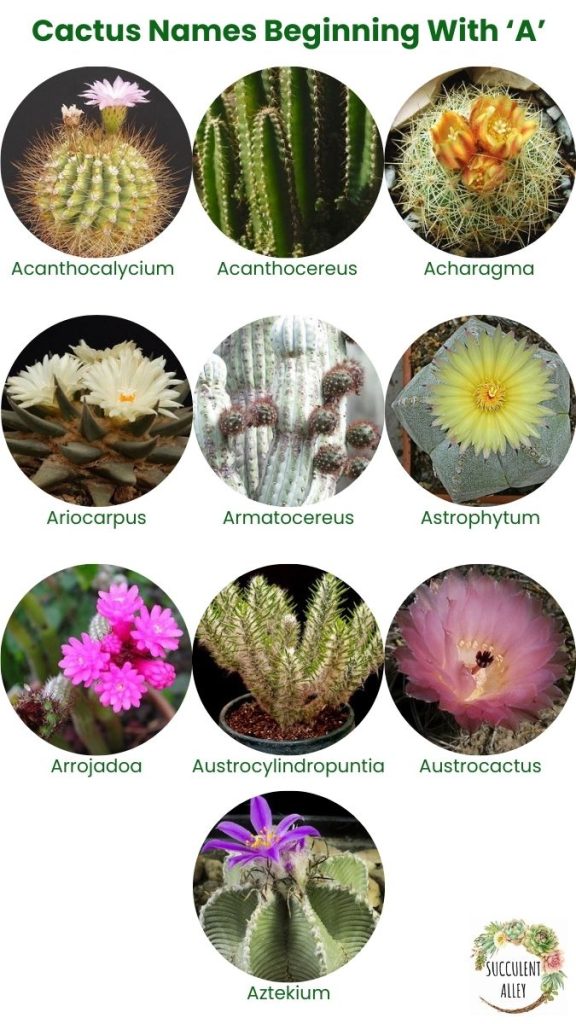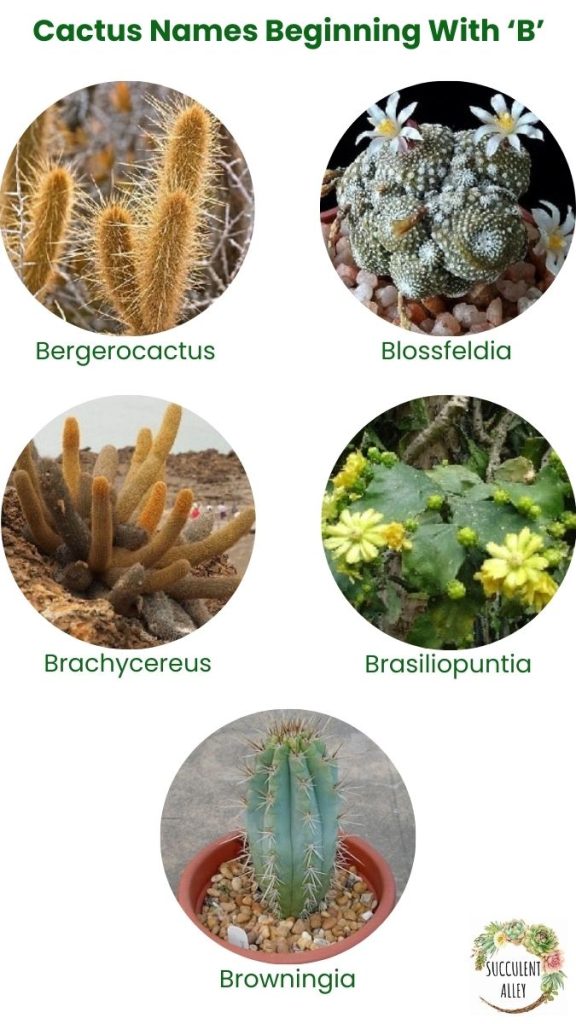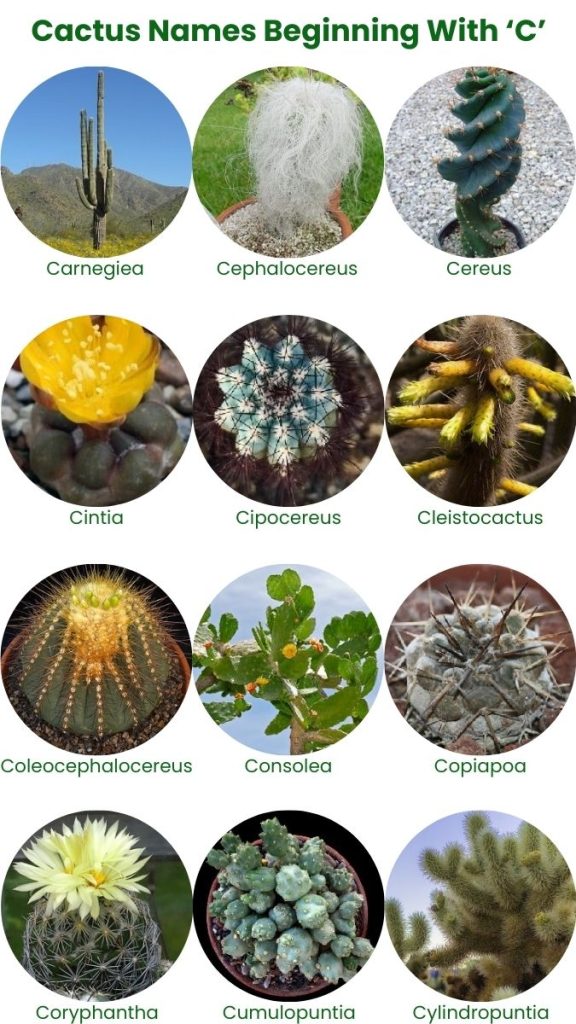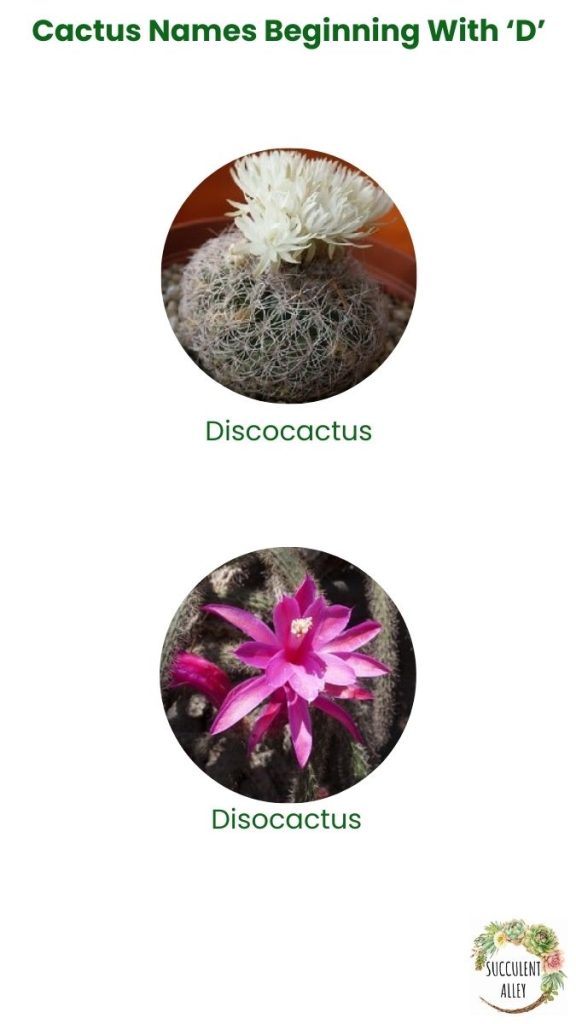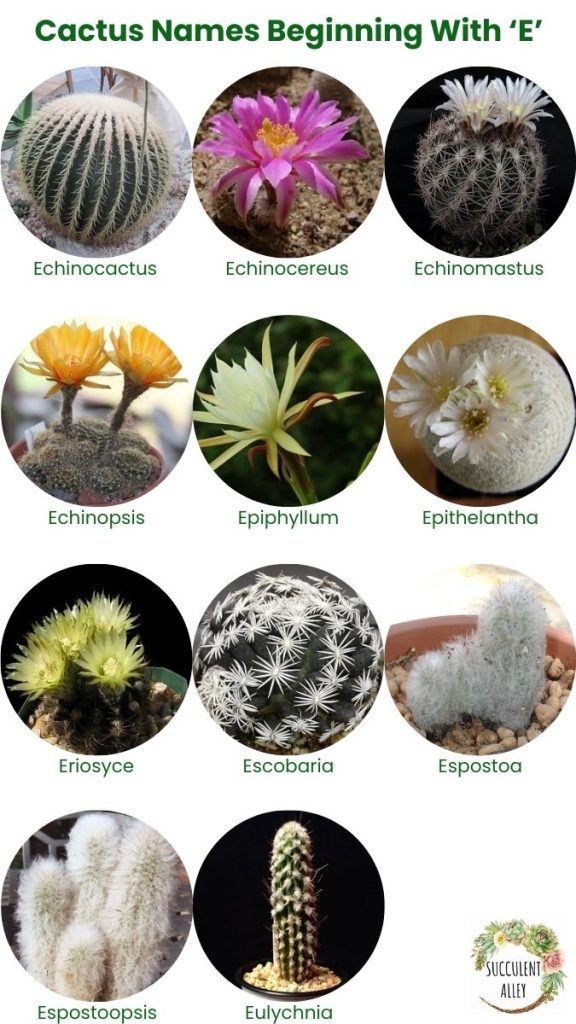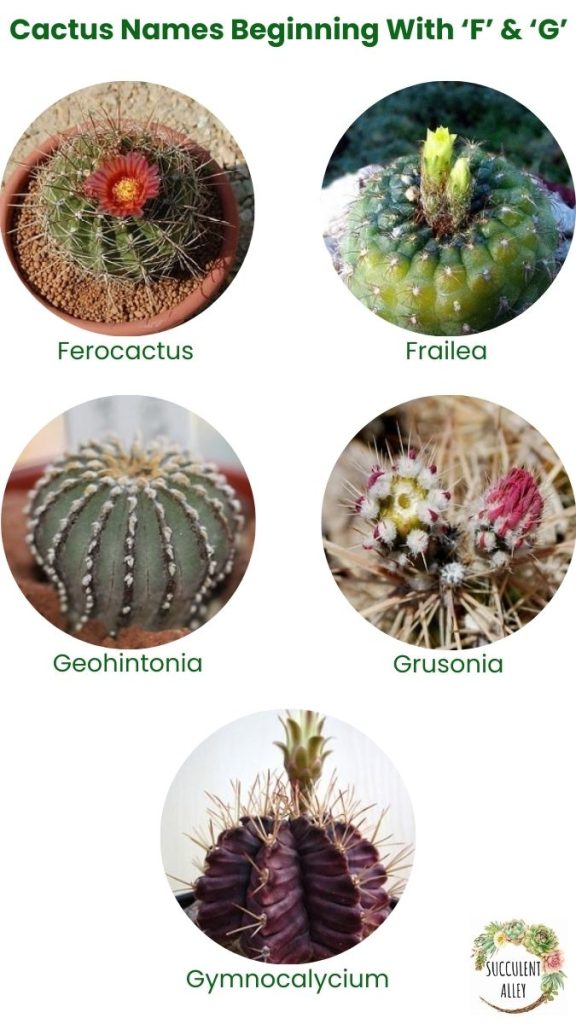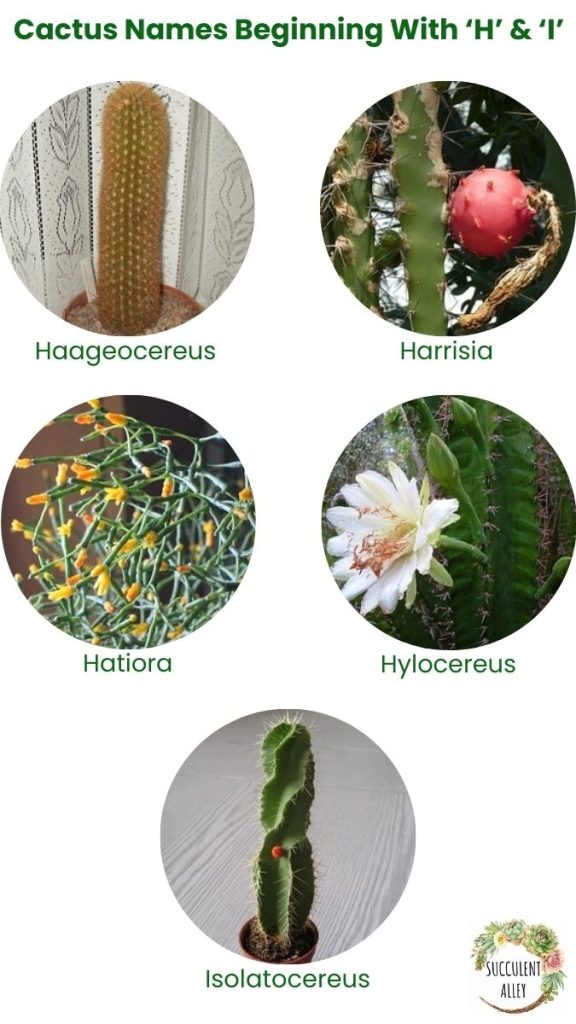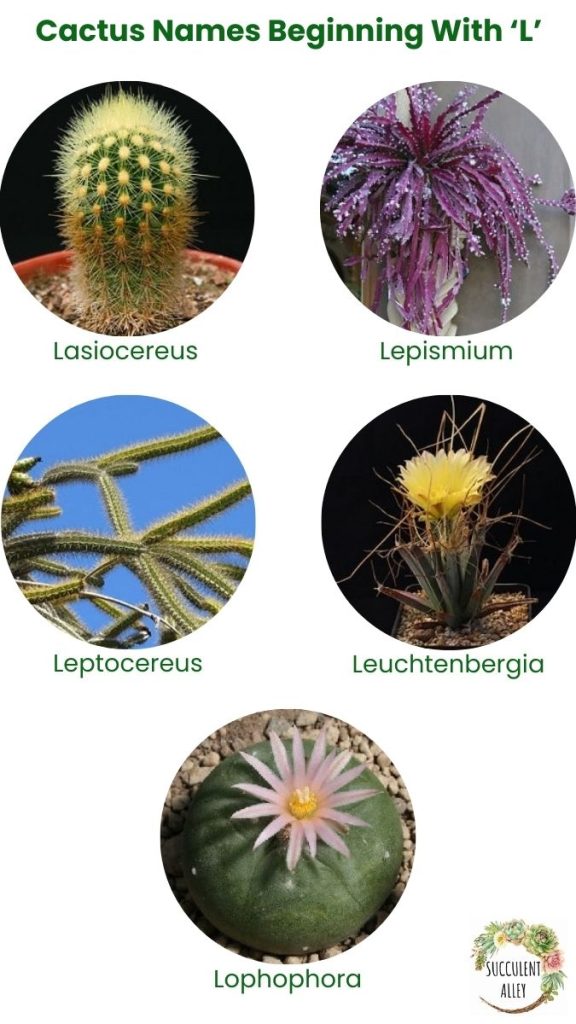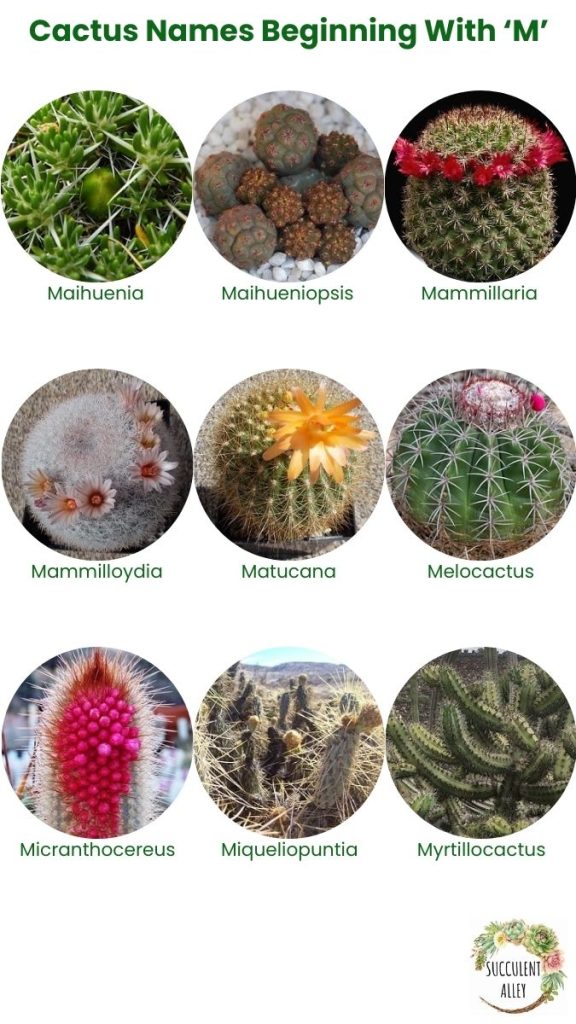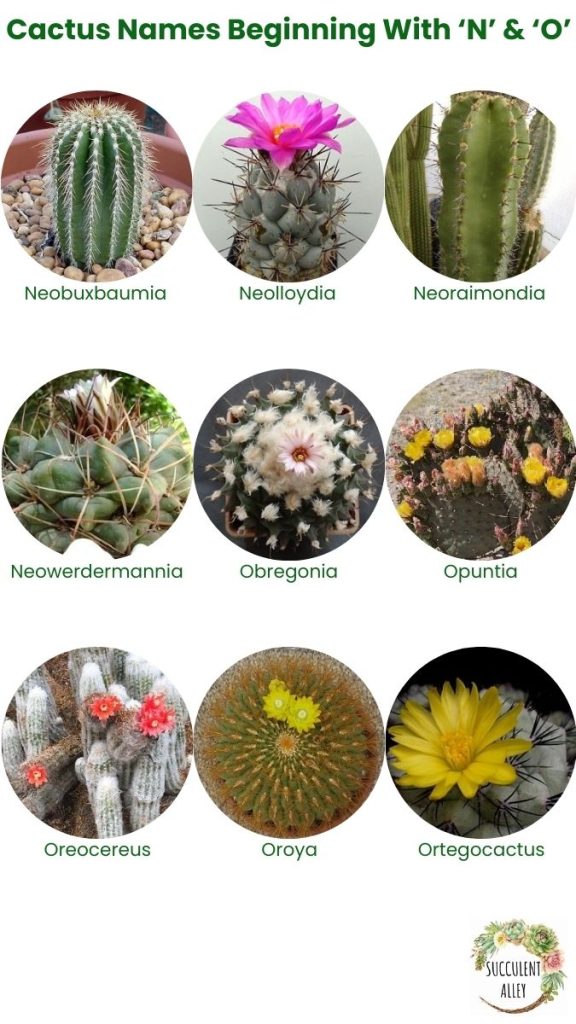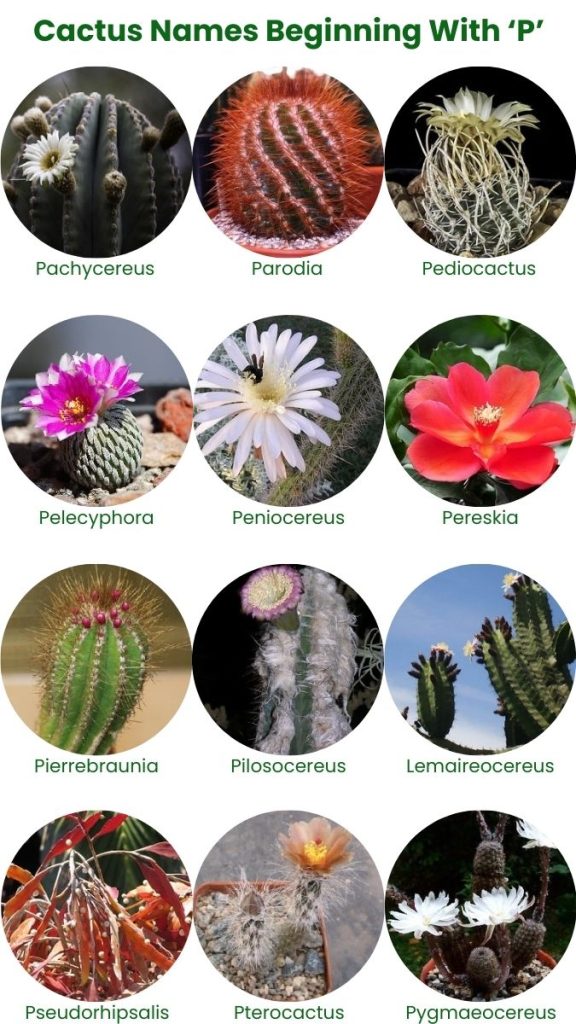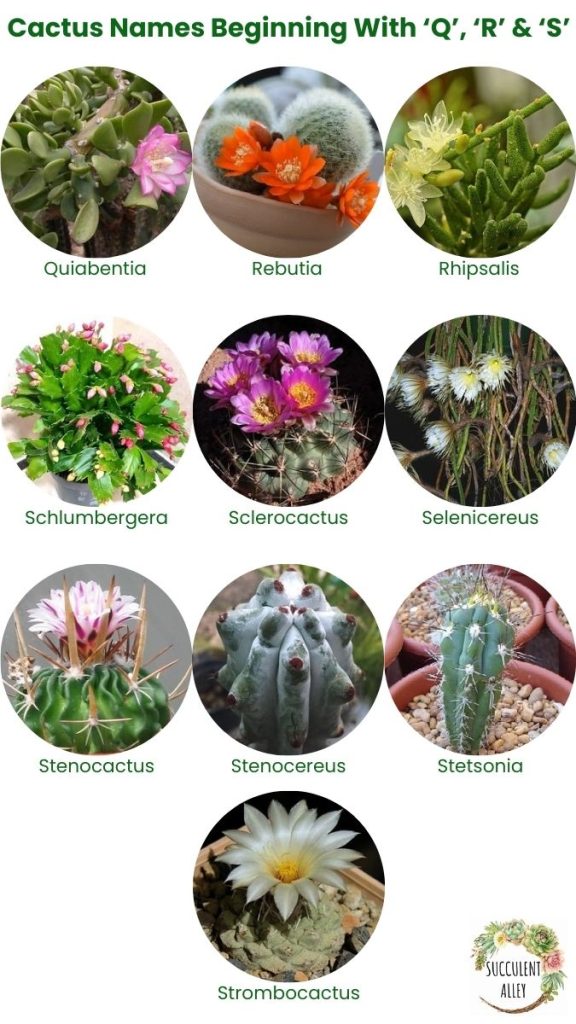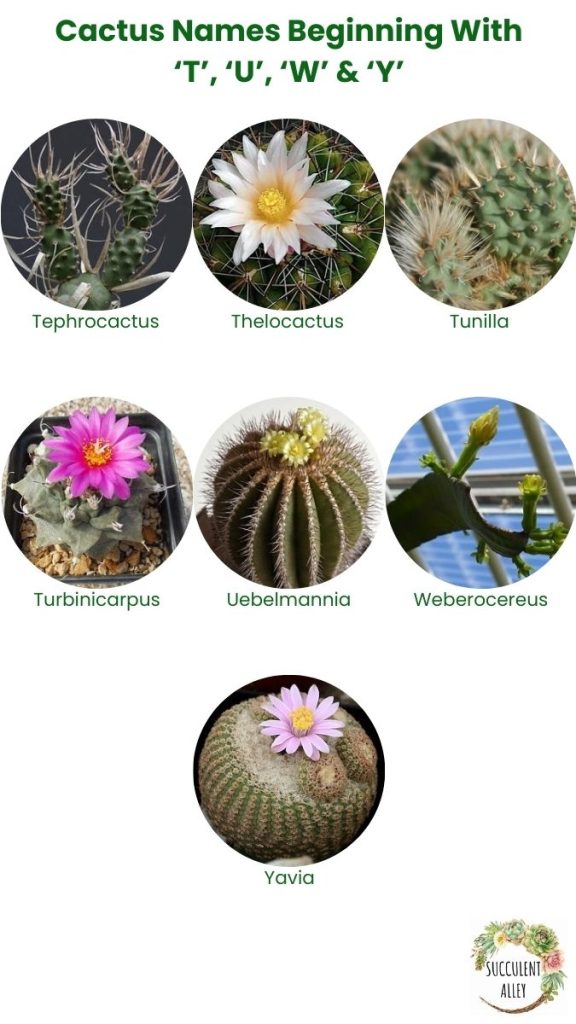1,000 Types of Cactuses with Pictures (Cactus Identification Chart)
Cacti are some of the most fascinating and unique plants on Earth! From the towering saguaro cactus standing tall in the desert to the tiny prickly pear with its bright flowers, these resilient plants have evolved incredible shapes and features to survive harsh, dry environments.
Can you imagine identifying over 1,000 different kinds of cacti? It’s an incredible world of spines, shapes, and surprising colors waiting to be explored. With pictures to guide you, separating all the different cactus genera will feel like an adventure through the desert’s botanical wonders. Get ready to be amazed by nature’s ingenuity!
Cactus Identification Chart
Contents
- 1 Cactus Identification Chart
- 2 Types of Cactus with Names and Pictures
- 2.1 Acanthocalycium
- 2.2 Acanthocereus
- 2.3 Acharagma
- 2.4 Ariocarpus
- 2.5 Armatocereus
- 2.6 Arrojadoa
- 2.7 Astrophytum
- 2.8 Austrocactus
- 2.9 Austrocylindropuntia
- 2.10 Aztekium
- 2.11 Bergerocactus
- 2.12 Blossfeldia
- 2.13 Brachycereus
- 2.14 Brasiliopuntia
- 2.15 Browningia
- 2.16 Carnegiea
- 2.17 Cephalocereus
- 2.18 Cereus
- 2.19 Cintia
- 2.20 Cipocereus
- 2.21 Cleistocactus
- 2.22 Coleocephalocereus
- 2.23 Consolea
- 2.24 Copiapoa
- 2.25 Coryphantha
- 2.26 Cumulopuntia
- 2.27 Cylindropuntia
- 2.28 Discocactus
- 2.29 Disocactus
- 2.30 Echinocactus
- 2.31 Echinocereus
- 2.32 Echinomastus
- 2.33 Echinopsis
- 2.34 Epiphyllum
- 2.35 Epithelantha
- 2.36 Eriosyce
- 2.37 Escobaria
- 2.38 Espostoa
- 2.39 Espostoopsis
- 2.40 Eulychnia
- 2.41 Ferocactus
- 2.42 Frailea
- 2.43 Geohintonia
- 2.44 Grusonia
- 2.45 Gymnocalycium
- 2.46 Haageocereus
- 2.47 Harrisia
- 2.48 Hatiora
- 2.49 Hylocereus
- 2.50 Isolatocereus
- 2.51 Lasiocereus
- 2.52 Lepismium
- 2.53 Leptocereus
- 2.54 Leuchtenbergia
- 2.55 Lophophora
- 2.56 Maihuenia
- 2.57 Maihueniopsis
- 2.58 Mammillaria
- 2.59 Mammilloydia
- 2.60 Matucana
- 2.61 Melocactus
- 2.62 Micranthocereus
- 2.63 Miqueliopuntia
- 2.64 Myrtillocactus
- 2.65 Neobuxbaumia
- 2.66 Neolloydia
- 2.67 Neoraimondia
- 2.68 Neowerdermannia
- 2.69 Obregonia
- 2.70 Opuntia
- 2.71 Oreocereus
- 2.72 Oroya
- 2.73 Ortegocactus
- 2.74 Pachycereus
- 2.75 Parodia
- 2.76 Pediocactus
- 2.77 Pelecyphora
- 2.78 Peniocereus
- 2.79 Pereskia
- 2.80 Pierrebraunia
- 2.81 Pilosocereus
- 2.82 Polaskia
- 2.83 Pseudorhipsalis
- 2.84 Pterocactus
- 2.85 Pygmaeocereus
- 2.86 Quiabentia
- 2.87 Rebutia
- 2.88 Rhipsalis
- 2.89 Schlumbergera
- 2.90 Sclerocactus
- 2.91 Selenicereus
- 2.92 Stenocactus
- 2.93 Stenocereus
- 2.94 Stetsonia
- 2.95 Strombocactus
- 2.96 Tephrocactus
- 2.97 Thelocactus
- 2.98 Tunilla
- 2.99 Turbinicarpus
- 2.100 Uebelmannia
- 2.101 Weberocereus
- 2.102 Yavia
- 3 What Type of Plant is a Cactus?
Types of Cactus with Names and Pictures
Acanthocalycium
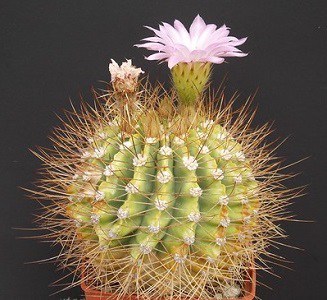
Acanthocalycium is a group of cacti that contains different types of plants from Argentina. The name of this group comes from the Greek words, ‘akantha’ and ‘kalyx’, which mean the spines found on the tubes of their flowers. These plants can have either a round or stretched-out shape, and their stems are covered in many ribs and spines. They grow in Argentina and have unique features that make them special among cacti.
Acanthocereus
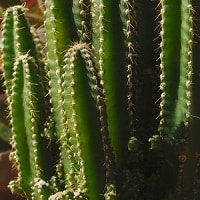
Acanthocereus cactus varieties are special types of plants that grow low and bushy or spread out with curved stems. These stems have a unique shape with 3 to 5 ribs, but sometimes they can have 2 or as many as 7 ribs, which is quite rare. The stems could be divided into segments or not.
All species of these cacti have white flowers that bloom at night, and some of them smell really nice. The spines on these cacti are short and thick, similar to thorns. The flower tubes have spines and scales, and the fruits they produce may or may not have spines. When the fruits are fully grown, they turn red and become round, filled with big black seeds surrounded by red pulp.
Acharagma
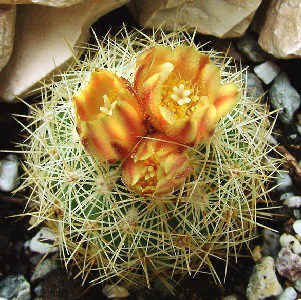
The Genus Acharagma consists of just two species found in Coahuila and Nuevo Leon-Mexico. These plants have round bodies that are less than 3 inches in diameter and no taller than 3 inches. They might have a shape that is somewhat cylindrical and usually grow individually, but sometimes they produce multiple new plants at the base.
Like Escobaria and Coryphantha, these plants have small bumps and flowers growing from the top. However, unlike the others, Acharagma plants don’t have a groove connecting the spot where the flowers grow to the main stem. In fact, the name Acharagma comes from Greek and means “no groove.” The flowers can be white, red, or yellow, and the sepals often have a darker vertical stripe. The spines on the plant are thick and can cover most of the stem, usually measuring less than an inch in length. The fruits they produce are small and smooth pods, which can be green or purple in color.
Ariocarpus
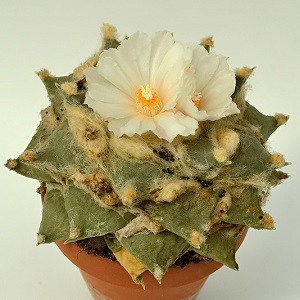
Ariocarpus is a highly respected genus among cacti enthusiasts for its unique features. These plants have a rugged, stone-like appearance and underground bodies, making them stand out among both cacti and other plants. Their slow growth adds to their allure, and seeing larger specimens, whether cultivated or in their natural habitat, is truly remarkable.
In the wild, Ariocarpus plants often grow close to the ground and may be mostly concealed beneath the soil, with extensive taproots. Harsh conditions give them an almost lifeless appearance. However, when cultivated under favorable conditions, these plants thrive and form plump mounds of green bumps, delighting grower enthusiasts. Ariocarpus plants are distinct from other cacti as they lack spines, except during the seedling stage. Their flowers emerge from the center of the plant and can vary in color from pinkish-red to white, with some displaying shades of yellow.
Related Post:
29 Types of Ariocarpus With Pictures
Armatocereus
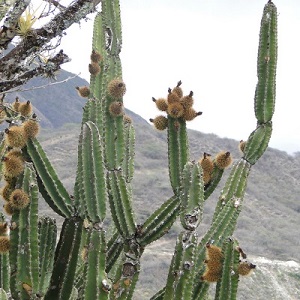
Armatocereus is a captivating group of cacti that are like the towering giants of the desert. These incredible plants can grow as tall as almost 40 feet, making them one of the tallest cacti in South America. Their stems are divided into segments, and each year’s growth forms distinct “pinch points,” creating a unique and textured appearance. The stems also have ribs, ranging from 3 to 16, and the genus gets its name “Armed Cereus” because of the spines it bears.
While some species have numerous, tough spines that can exceed 4 inches, others have very few or even none. The flowers of Armatocereus are white, with occasional red blooms, and they have spines on their floral tubes. The fruits can be either red or green, and they are covered in spines until they ripen. Interestingly, the dried flowers remain attached to the fruits, resulting in an intriguing sight. While Armatocereus is not commonly grown in cultivation, it is not more challenging to cultivate than other columnar cacti.
Arrojadoa
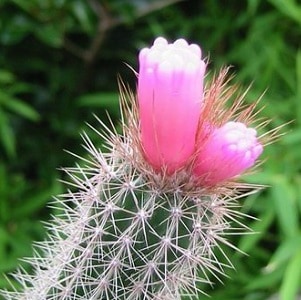
This group of cacti is native to Brazil and consists of different species that grow in dense clusters of slender cylindrical stems branching from the base. In one species, the stems can reach a diameter of 3 inches, while in others, they are much thinner and can grow as tall as 6 1/2 feet. The plant’s body is covered with closely spaced and bristly spines, making it difficult to see the small ribs underneath.
When the flowering season arrives, the flowers emerge from the very tip of the plant, creating distinct growth rings as the stem continues to grow. This results in a collar of spines between the new and old stem sections. The flowers resemble sweet, waxy tubes and display vibrant colors such as pink, red, white, or yellow. However, their blooming period is short-lived, lasting only one or two days before turning black and falling off. The fruits produced by these cacti are small, juicy berries that can be pink, purple, or red in color.
Astrophytum
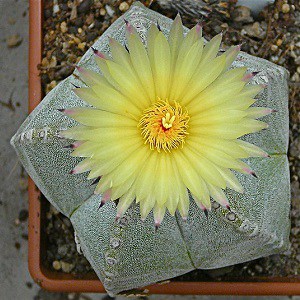
The name Astrophytum comes from two Greek words: “astron,” meaning “star,” and “phyton,” meaning “plant.” It perfectly describes this genus, as all the species in it have a star-shaped appearance when viewed from above. There are four main species of Astrophytum, which are round or slightly cylindrical. They are often compared to sea urchins due to their unique resemblance.
In addition to these four species, a fifth member called A. caput-medusae was discovered in 2001. It stands out not only within the Astrophytum genus but also among all other cacti. Some enthusiasts believe it should have its separate genus called Digitostigma, named after its long, tentacle-like tubercles. All five species, including caput-medusae, have a flocking of white trichomes on their surface, although some cultivated forms lack this feature. They also produce yellow flowers with fuzzy tubes and eventually develop dry seed pods filled with relatively large, black seeds that are easy to germinate.
Related Post:
111 Types of Astrophytum With Pictures
Austrocactus
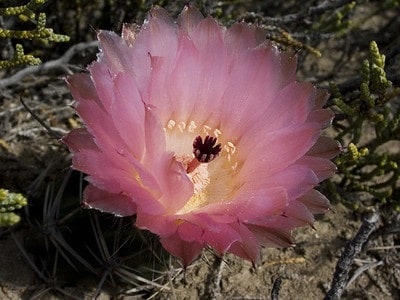
Austrocactus is a group of cacti that includes ten species found only in southern South America, specifically Argentina and Chile.
These plants can have either a single body or branches growing from the base. The ribs on their stems are typically divided into tubercles, except for Austrocactus spiniflorus. The tallest species in this genus can grow up to 31.5 inches. The flowers they produce come in various colors like pink, orange, red, or yellow and have a unique tube covered in spines.
Austrocylindropuntia
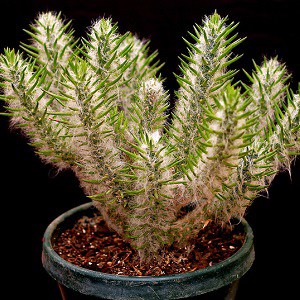
Austrocylindropuntia is the South American version of Cylindropuntia, and it got its name from the prefix “Austro” meaning southern. This group of cacti is different from Cylindropuntia not only because they come from a different geographical region but also because they have distinct characteristics. These cacti belong to the opuntiads family and have round succulent leaves on new growth. As they age, these leaves fall off. You can easily identify them by the glochids, tiny hair-like structures, within the areoles.
Unlike Cylindropuntia, Austrocylindropuntia doesn’t have papery sheaths on its spines. Additionally, its stems grow without distinct segments between growth points. The flowers of Austrocylindropuntia can be yellow, orange, or red and are found on stout spiny tubes. The fruits are thick and rounded.
Aztekium
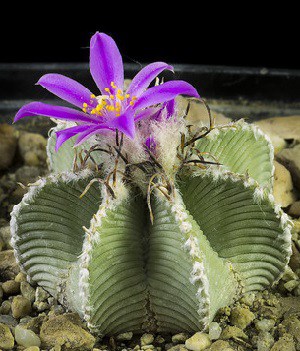
The Aztekium genus consists of two species, which were discovered more than 60 years apart. Despite the time gap, these species clearly belong to the same genus. They are found growing on vertical or near-vertical gypsum cliffs in the Mexican state of Nuevo Leon. These cliffs are challenging environments where not much else can survive. Unfortunately, due to illegal collecting, these species face a high risk of extinction in the wild and require serious protection.
Both species have a star-shaped appearance. The first species discovered, A. ritteri, has rounded ribs with many wrinkles, giving even young plants an ancient look. On the other hand, A. hintonii has more distinct and pointed ribs with consistent banding across them. Neither species has prominent spines. They are relatively small, with stems that don’t exceed 4 inches in diameter, usually, half that size. A. hintonii stays as a single plant, while A. ritteri tends to form clusters as it grows older.
Bergerocactus

Bergerocactus emoryi, also known as golden cereus or golden snake cactus, is a unique cactus species. It belongs to the Bergerocactus genus, which is named after Alwin Berger. Although it shares its common name with another cactus called Echinocereus pensilis, it is the only member of the Bergerocactus genus.
The golden cereus is sometimes referred to as a snake cactus because of its appearance. However, it is important to note that the name snake cactus can also apply to Echinocereus pensilis, another type of cactus.
Blossfeldia
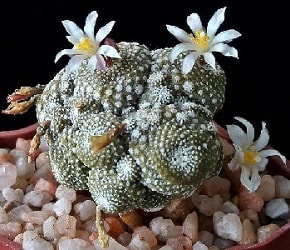
Blossfeldia is a fascinating single-species genus of cacti that captures our curiosity. It holds the title for being the smallest cactus, with a maximum size of only 1/2 inch (12mm) in diameter. Its species name, liliputana, reflects its petite nature, inspired by the tiny people of Lilliput in the famous novel Gulliver’s Travels. These special plants can grow individually as small buttons or cluster together with multiple stems. Unlike other cacti, they lack ribs, tubercles, or spines. The delicate white flowers of Blossfeldia are especially noteworthy, as they can sometimes even exceed the diameter of the entire stem.
Blossfeldia finds its habitat on the eastern side of the Andes mountains, spanning across Bolivia and Argentina. Remarkably, it thrives in harsh conditions, with elevations ranging from 4,000 to nearly 12,000 feet. This incredible species has adapted to survive the extreme dryness of its environment, showcasing its resilience in the face of adversity.
Brachycereus
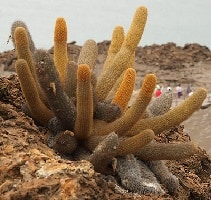
Brachycereus is a unique genus of cacti found in the Galapagos Islands. Its name comes from the Greek word “brachys,” meaning short, which describes its relatively low stature. One species, Brachycereus nesioticus, stands out for its ability to grow in challenging conditions.
This cactus forms clusters of cylindrical stems on barren lava flows, where few other plants survive. With a height of about 2 feet and covered in yellow to brown spines, it stands resilient. The white flowers of Brachycereus bloom on long, narrow tubes that reach just over 4 inches in length. The strict protection measures in the Galapagos Islands make this genus virtually unknown in cultivation, along with the reported difficulties in growing Brachycereus.
Brasiliopuntia
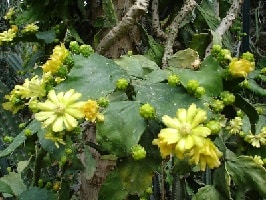
Brasiliopuntia is a special group of cacti within the Cactaceae family. This genus consists of only one species known as Brasiliopuntia brasiliensis. You can spot this cactus in countries like Brazil, Paraguay, eastern Bolivia, Peru, and northern Argentina. Interestingly, it has also adapted and grown naturally in places like Florida and other regions.
Browningia
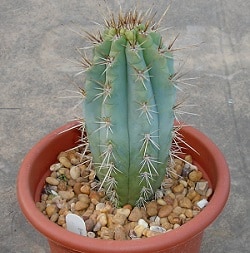
Brachycephalocereus is a group of impressive columnar cacti that resemble trees and can reach heights of up to 33 feet. Many of these cacti have multiple shallow ribs and may also have bumps called tubercles. What’s interesting about these species is that they have a unique spine pattern: when they are young, they grow heavily spined, but as they mature, they develop fewer spines.
The flowers of Brachycephalocereus can be either white or red, and they have large scales on their floral tubes. The fruits produced by these cacti are small. Originally from Bolivia, Chile, and Peru, they are not commonly grown in cultivation.
Carnegiea
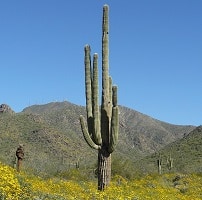
The Saguaro cactus, scientifically called Carnegiea gigantea, is the only species in its unique genus. It’s easily recognizable and considered the classic representation of a cactus. You’ve probably seen it on postcards, book covers, cartoons, and paintings, as it symbolizes the desert Southwest and the broader Western culture. Interestingly, these iconic cacti are limited to certain areas. They mainly occur in central and southern Arizona, with a small portion extending into California along the Arizona border. This is quite different from the widespread perception of the Wild West that many people associate with these cacti.
Standing beneath these magnificent Saguaro giants is truly an awe-inspiring experience. They are unlike anything else in the plant world, with their leafless, succulent, and spiny bodies. What makes them even more remarkable is their impressive height, reaching over 50 feet, and their monstrous branches. With such extraordinary features, it’s no wonder that these towering cacti have fuelled endless folklore and inspired countless tales.
Cephalocereus
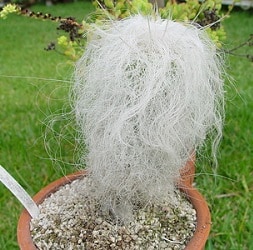
Cephalocereus is a type of cactus that grows slowly and can reach heights of about 50 feet. However, one species called C. senilis is quite popular for its unique appearance. This species has long white hair that covers the smaller plants, making them resemble “Cousin It” from The Adams Family. The other species are not as well-known in cultivation but also have wool or hair. These cacti produce flowers on the side of their head, which is why they are called cephalium. All six species of this cactus genus can be found in southern Mexico.
Cereus
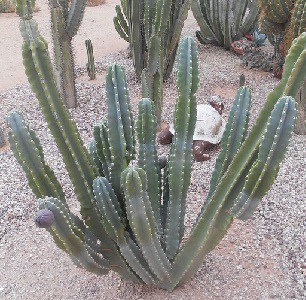
In the past, the name Cereus was used for most cacti species that were tall, ribbed, and columnar. However, many of these plants have been placed into different groups. As a result, the remaining 30 or so plants in the Cereus group are mostly there because they haven’t been moved to another genus, rather than because they specifically match the description of Cereus. This grouping becomes messy and unsatisfactory.
A typical Cereus cactus is a large, tree-like plant with well-defined ribs, big spiky areas called areoles, and strong, medium-sized thorns. Their flowers are large, white, and usually open at night, with smooth or slightly scaly tubes. They also have a pleasant fragrance. Some species that fit this description include C. hexagonus, C. hildmannianus, C. jamacaru, C. lanosus, and C. repandus. However, there are exceptions like the sprawling climbers C. albicaulis, C. spegazzinii, and C. kroenleinii. C. insularis looks bushy and thin-stemmed, resembling the Cleistocactus genus, and C. mortensenii has a growth on top that looks like a head.
Related Posts:
11 Cereus Cactus Types With Pictures
Cintia
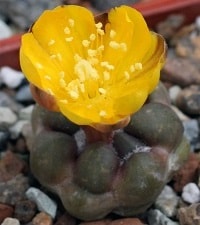
Cintia knizei is a tiny cactus that grows in the high Andes of Bolivia. This special plant was found by Karel Kníže in 1969 at a height of 13,000 feet (4,000 meters) near Otavi, in the Potosí Department of Bolivia. But it wasn’t officially described until 1996 by Jan Říha.
Cipocereus
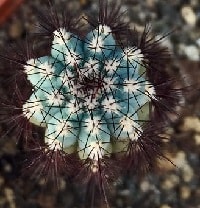
Cipocereus is a small group of cacti found in Brazil. These cacti are short and columnar. What makes them stand out is the blue color of their fruits. The fruits have a watery pulp inside, and this characteristic helped in classifying them under the Cipocereus genus. The genus was established in 1979 by F. Ritter. Before that, some of the species were placed in different genera. After the creation of the Cipocereus genus, a few species were relocated from other groups, and a new species that had not been named before was also discovered.
Cleistocactus
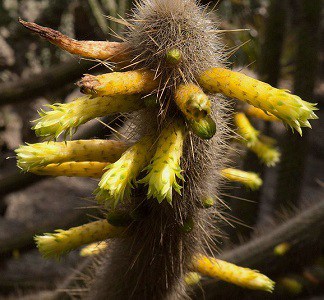
The Cleistocactus genus got its name from the Greek word “Cleistos,” which means closed. This refers to the flowers of these cacti, as they rarely fully open. In some ways, it can be said that Cleistocactus focuses more on quantity than quality. The stems of these cacti are usually about an inch in diameter, but they branch out easily from the base, forming noticeable clusters. The spines, though small and flexible, are densely packed, often covering the stems. The flowers also follow this pattern. Many species have flower buds that look like little tubes of lipstick or firecrackers. The stems can be adorned with numerous flowers, sometimes blooming all year round under the right conditions.
Cleistocactus can be found in various parts of South America. They grow in large, bushy clumps alongside other plants or even climb over rocks. Some species from this genus are highly favored in cultivation and are commonly seen in nurseries worldwide. Among the most popular cacti in this genus are C. strausii and C. winteri.
Related Post:
55 Types of Cleistocactus With Pictures
Coleocephalocereus
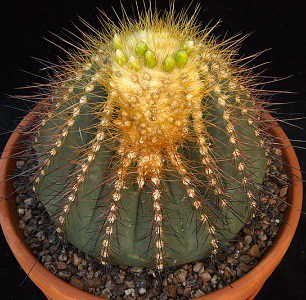
Coleocephalocereus is a group of tall and partially tall cacti found in Brazil. These plants grow in an upright or semi-upright manner and form a woolly and bristly structure called a cephalium. They are commonly found on rocky outcrops called inselbergs in the Brazilian Atlantic rainforest. In these isolated dome-shaped rocky areas, they can be a dominant part of the plant life.
All species in this genus are relatively short and columnar, except for a subspecies of C. aureus that has a rounder shape. The stems have multiple shallow ribs, which can be slightly bumpy or mostly straight. The cacti have moderate spines that grow closely together from small and closely spaced areas called areoles. One distinct characteristic of this genus is the presence of a side cephalium, from which small tubular flowers in white or red colors bloom. The fruits of these cacti are small, round, and reddish in color.
Consolea
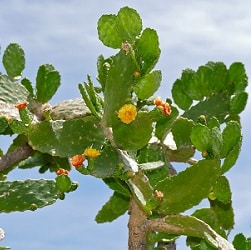
Consolea is a group of cacti mainly found in the Caribbean, including Florida in the United States. These cacti are like small trees, reaching a maximum height of 20 feet. They begin as flat pads called cladodes, which later transform into round trunks. At the top of these trunks, new cladodes grow in a messy arrangement, resembling leaves. This unique feature of straight, round, unsegmented stems helps identify the Consolea genus.
Moreover, the flowers of Consolea cacti have distinct qualities not seen in other cacti of the Opuntia family. This includes unique seeds, pollen, and floral nectaries. The flowers themselves are usually small, less than 1 inch in diameter, and emerge from comparably large pericarpels, which may or may not have spines.
Copiapoa
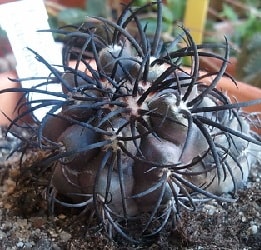
Copiapoa is a beloved genus among cactus growers for its unique characteristics. Unlike other cacti known for large flowers, Copiapoa species show a wide range of variations. These cacti generally have a round or cylindrical shape with well-defined ribs and a fluffy top, giving rise to yellow flowers. These funnel-shaped flowers are mostly 1 to 2 inches in diameter and look quite similar across different plants.
However, Copiapoa cacti differ when it comes to spines. Some may have long and fierce spines, while others may have barely any spines at all. Their roots also exhibit variation, with some having fibrous roots and others having large tubers underground, bigger than the visible portions above ground. Some Copiapoa plants grow individually, while others form clusters with hundreds of stems, creating impressive mounds several feet across. The color of these cacti can range from blue-green to deep green or brown. Identifying a specific Copiapoa species can be challenging due to these variations.
Coryphantha
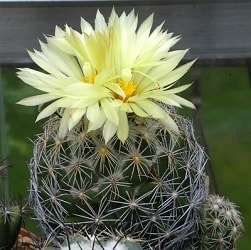
Coryphantha, also known as the beehive cactus, is a small round plant with grooved tubercles instead of ribs. It belongs to a group of similar plants called Mammillaria and Escobaria. Coryphantha flowers grow on the top of the plant’s new growth, while Mammillaria flowers appear in rings further down the plant.
On the other hand, Escobaria also flowers from the top, like Coryphantha. In the past, many Escobaria plants were considered part of the Coryphantha genus. The main difference between them is the seed coats: Coryphantha has a net-like pattern, while Escobaria has pitted patterns.
Cumulopuntia
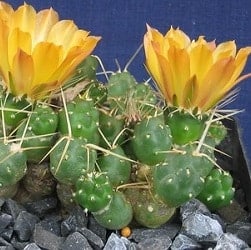
Cumulopuntia is a different group of cacti that was originally considered a part of the Opuntia genus. However, it was later recognized as a separate genus by F. Ritter in 1980. This distinction is based on the fruit, which lacks pulp, and the unique structure of the seeds. Cumulopuntia plants grow in a compact cushion shape.
Initially, over 30 species were identified, but the number was reduced to 20 by Anderson and further reduced to just 4 species (with 4 subspecies) in The New Cactus Lexicon. These cacti are mostly found at high elevations in south-central South America. They are not easy to find in cultivation, as they are limited to specialist nurseries or exchanged between growers. Similar to other Opuntiads, these cacti have polarizing opinions among cactus enthusiasts, with many growers having mixed feelings about them.
Cylindropuntia
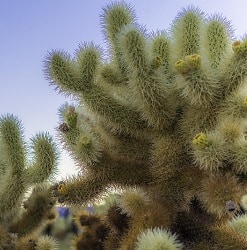
The Cylindropuntia cacti, commonly known as “Cholla,” are not commonly grown except by avid Opuntia enthusiasts. However, they are well-known in the deserts of the Southwest United States and Northern Mexico. These cacti have segmented cylindrical stems that resemble small trees, typically not growing taller than 10 feet.
Most Cholla species have spiny stems covered with a papery sheath, which may fall off over time, giving some species a silver or gold appearance. The spines have reverse barbs, making them stick to the skin and causing great pain when removed. Some Cholla species are called “Jumping Cholla” because their stem segments easily detach and cling to unsuspecting victims. These segments can grow into new plants when spread by animals.
Discocactus
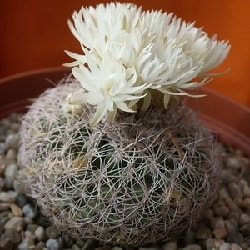
The Discocactus genus is highly valued by collectors worldwide. It’s not entirely clear what makes them so appealing, but their relatively small size, striking white flowers, and slow growth are likely contributing factors. These cacti have flat to round shapes, with stems that are usually less than 3 inches tall and 10 inches wide. The stems have ribs or small bumps and may be covered in fuzzy areas or dense spines.
Most Discocactus plants grow individually, but some may form clusters. When these cacti bloom, they develop a wooly growth at the top with beautiful white flowers that have a long, thin tube. The flowers, which open at night, are highly fragrant and often considered the best-smelling cactus flowers by many growers.
Disocactus
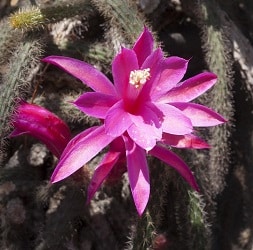
Disocactus is a genus of cacti that mostly grow in tropical jungles, rather than deserts like many other cacti. Most species of Disocactus are found in Central America, Southern Mexico, and some parts of northern South America and the Caribbean islands. The stems and flowers of Disocactus species vary greatly, which causes a lot of debate among experts about how to classify them. Some species are also known by different names like Ackermannia, Nopalxochia, and Wittia.
The stems of Disocactus can be long, flat, and leaf-like, similar to those of the Epiphyllum genus. Others have cylindrical shapes and spines. The flowers, which are a defining feature of this genus, are mostly large, colorful, and funnel-shaped. Disocactus is also responsible for many popular “Epi” hybrids. However, some species have narrow, bilaterally symmetrical flowers, while others have small, tube-shaped ones.
Related Post:
16 Types of Disocactus With Pictures
Echinocactus
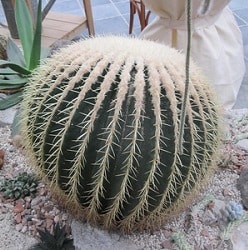
The Echinocactus genus now includes only six species, although historically it included hundreds of species. The name Echinocactus was used to group barrel-shaped cacti with ribs that were not already classified under Cereus or Melocactus. However, some cactus experts believe that the remaining six species should be classified into separate genera since they have distinct differences.
Despite the debates, the remaining Echinocactus species share common traits. They develop a dense, wooly growth at the top of the plant, which gives rise to the flowers. These cacti have a barrel shape with clear ribs and robust spines. Their flowers are yellow or pink and funnel-shaped. Echinocactus species resemble the Ferocactus genus, except for the wooly apex. The fruits can be dry and wooly or fleshy and round.
Related Posts:
10 Types of Echinocactus With Pictures
Echinocereus
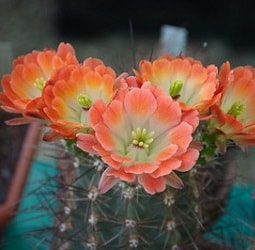
Echinocereus is a type of plant loved by cactus growers worldwide. They are small plants, perfect for growing in pots and greenhouses. The stems are usually less than a foot tall and about 2 to 3 inches wide. Some are a little bigger, some are smaller. In the wild, some species can form large mounds with hundreds of stems, but it takes many years for this to happen.
Echinocereus cacti have a wide variety of spines. Some have fierce and dramatic spines that cover the stem completely, making it invisible. Others have evenly distributed moderately sized spines, and some even have colorful spines in alternating patterns. Some species have comb-like spines, while others are almost spineless. The spines are arranged on ribs.
These cacti produce some of the most brilliant flowers in the cactus family. The flowers come in colors like electric pink, deep scarlet, translucent browns, greens, and bright yellow. Many species have flowers with two colors, with one color in the center and another on the outer parts of the flower.
Related Post:
146 Types of Echinocereus With Pictures
Echinomastus
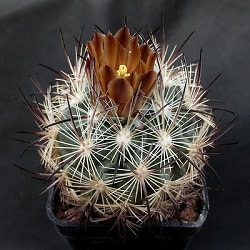
Let’s talk about another type of cactus called Echinomastus, which is found in the Southwestern United States and nearby Mexico. This group of cacti is relatively small, with about 5 to 9 species. They have short, elongated, round shapes. You can easily identify these cacti by picture. These cacti usually don’t grow taller than 12 inches and their stems are covered in lots of spines, making it hard to see the actual stem. The spines grow from specific points on the cactus in rows. Sometimes, there are grooves on these points and there may also be extrafloral nectaries.
The flowers of Echinomastus come in colors like red, pink, cream, or even brown. They have a funnel shape and bloom during the day. The flowers sprout from the tips of the cactus’s spiny points and often have to push through the surrounding spines. When the fruits are ripe, they open either at the bottom or split lengthwise.
Echinopsis
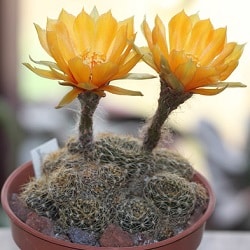
There are over 100 species in this genus, and they show a lot of variation. Echinopsis plants can range from small, flattened round shapes to giant, treelike ones. This leads to many different names for the same species, which can be frustrating when trying to sort through them.
In more recent thinking, the Trichocereus and Lobivia genera have been included with Echinopsis. The main feature that connects these plants is their large and showy flowers. The flowers have a funnel shape and hairy or wooly scaled tubes, which produce round fruits filled with soft pulp. The flowers usually last only a day and can bloom during the day or night, depending on the species. These cacti can easily crossbreed, leading to a huge number of hybrids that some cactus growers specialize in.
Related Post:
82 Types of Echinopsis With Pictures
Epiphyllum
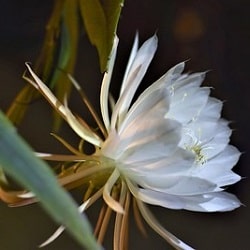
Epiphyllum is a type of epiphytic cactus with 19 different species that can be found in Central America. Some common names for these cacti are climbing cacti, orchid cacti, and leaf cacti, but the term “leaf cacti” can also refer to another type of cactus called Pereskia.
Related Post:
12 Types of Epiphyllum With Pictures
Epithelantha
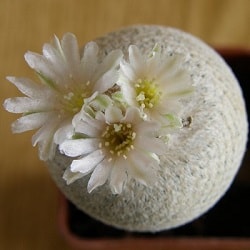
Epithelantha is a genus of just two species of small cacti. There are variations in the spines, but most experts have settled on just the two species and described the variations as subspecies. The plants are tiny, with stems that are usually less than 2 inches in both diameter and height. The white spines grow out of tubercles, similar to another type of cactus called Mammillaria.
One way to identify Epithelantha is by looking at its flowers. The flowers emerge from the same area where the spines grow, at the end of the tubercles. This makes Epithelantha different from Mammillaria. The flowers themselves are small, light pink, or white funnels that look delicate. While these little flowers may go unnoticed, the fruit of Epithelantha is quite eye-catching. The fruits are long tubes that stick up like birthday candles, and their bright red color stands out against the white spines.
Eriosyce
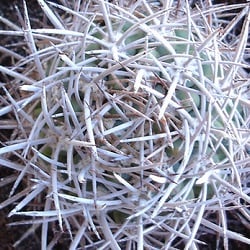
Eriosyce is a group of cacti mainly found in South America. They have round, ribbed stems covered in dense, strong spines. Originally, they were thought to belong to the Echinocactus genus, but since Rudolph Philippi in 1872, it has been established that they are separate. In the past, there have been different names used for these cacti, including Neoporteria, Neochilenia, and Islaya.
The Neochilenia group is characterized by short to no spines and funnel-shaped flowers. Their floral tubes are hairy and later develop into fleshy fruits. On the other hand, the Neoporteria group has denser and longer spines compared to Neochilenia. Their flowers are bright pink with yellow interiors, forming a tube shape when open. However, the inner parts are still covered by petals. The Islaya group is highly variable and can be found in Chile and Peru.
Escobaria

Escobaria plants have small round or cylindrical stems with bumps called tubercles. In the past, some of these plants were thought to belong to other cactus groups like Mammillaria and Coryphantha, but they are now classified as Escobaria.
One difference between Escobaria and Mammillaria is how they flower. Escobaria blooms from new growth at the top, while Mammillaria flowers from its sides. Another distinction is that Escobaria’s tubercles don’t have separate parts for producing spines and flowers, unlike Mammillaria. Another cactus group called Coryphantha has seeds with a crisscross pattern, while Escobaria’s seeds have pits. However, there are other ways to tell Escobaria apart, such as the lack of extrafloral nectaries, fringed edges on its flowers, falling off of tubercles as they age, and smaller pinkish flowers.
Espostoa
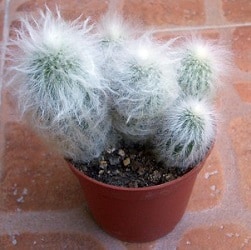
Let’s talk about Espostoa, a group of cacti found in Ecuador, Peru, and Bolivia. These tall columnar plants have stems that resemble a city skyline, branching at the base. One of the most striking features of Espostoa is the dense, white “hair” covering their stems, giving them a soft and fuzzy look. However, underneath this fuzziness lie sharp spines that are arranged on small ribs encircling the columns. Some species even have long central spines that stand out among the hair, making them look threatening.
In cultivation, certain species of Espostoa are quite popular because of their fuzzy appearance. They are commonly sold as 6-12-inch stems by commercial growers. However, when these large columnar plants are grown in pots, they don’t grow as vigorously as they would in the ground. They tend to fill up the pots quickly, which slows down their growth. Due to this, they rarely reach maturity, which means they don’t produce a special part called the cephalium and, as a result, don’t flower. On the other hand, in warmer climates, where people can plant these cacti directly in the ground, they can form impressive clusters of stems and eventually flower.
Espostoopsis
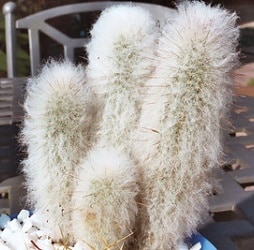
Let’s learn about Espostoopsis, a genus of cacti similar to Espostoa. However, there are some interesting differences. While most Espostoa species are found in western South America, Espostoopsis is native to Brazil. Taxonomists initially placed this species in other genera like Austrocephalocereus and Coleocephalocereus before giving it a unique name in 1968.
In contrast to Espostoa, Espostoopsis has naked flower tubes, similar to Coleocephalocereus and Micranthocereus. The fruits and seeds of Espostoopsis are variable, but they have dark, tuberculate seeds, unlike Espostoa’s smooth or rougher seeds. Differences in fruit stems also arise from these dissimilarities in flowers.
Eulychnia
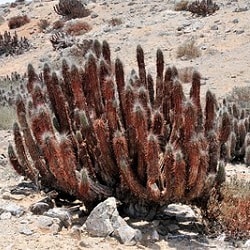
Let’s explore the fascinating Eulychnia genus of cacti. These remarkable plants can reach up to 23 feet (7m) tall and are found in the deserts along the coasts of Chile and Peru. These deserts hardly receive any rainfall, but the plants manage to survive by relying on the condensation caused by the heavy fog in the area. In their natural habitat, Eulychnia species grow as large shrubs or trees with numerous branches.
The stems of these cacti are covered in long spines arranged on ridges. The flower tubes are also covered in spines, wool, scales, or sometimes all three. When the flowers bloom, they form a round shape that resembles a ball that has burst open on one side.
Ferocactus
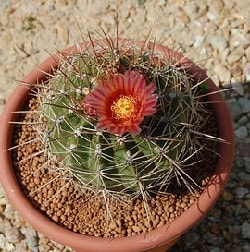
Let’s talk about Ferocactus, a remarkable genus known for its iconic barrel shape that is often depicted in desert art, cartoons, and movies. These cacti have become known as “The Traveler’s Friend” due to a belief that they store fresh drinking water in their barrels, waiting to be tapped by lost and thirsty wanderers. However, in reality, it is not recommended to drink water from Ferocactus as it is too alkaline and can worsen dehydration. Instead, a better source of water can be found in the flattened leaf-like pads of the nearby Opuntia cacti.
The species in the Ferocactus genus generally have barrel-shaped or round stems, with some forming clumps of multiple stems. These stems have ribs and can be straight or slightly bumpy. Ferocactus plants have stout spines, some of which are thick and heavy, and may be straight or hooked. The spines come in various colors, such as yellow, gray, white, brown, pinkish, or even brilliant red. Central spines may have ridges running perpendicular to them.
Related Post:
44 Types of Ferocactus With Pictures
Frailea

Let’s learn about Frailea cacti, which are small and can be either solitary or grow in clusters. Their flattened round stems typically don’t exceed 2 inches in diameter. These stems have shallow ribs that can be straight or wavy. If there are any spines, they are tiny and pose no threat to our fingertips. The yellow flowers of Frailea are often larger than the stems themselves and may open briefly during the hottest part of the day, or sometimes not at all.
One interesting thing about Frailea is that they are cleistogamous, which means that their flowers often don’t even emerge. Instead, they self-pollinate inside the plant. Sometimes, growers are surprised to find fruits with seeds on their plants, even if they haven’t noticed any flowers before. Fresh seeds have a high chance of germinating easily, and sometimes they are already sprouting at the base of the main plant without the owner even knowing the seeds were there.
Geohintonia

Let’s explore Geohintonia, a unique genus consisting of a single species. These cacti have a distinctive appearance that sets them apart from others. The shape of their body can be round or somewhat columnar as they grow older. They display around 20 prominent ribs with flat sides that resemble cooling fins on a circular radiator.
The plants have a frosty, blue-grey color. Along the edges of the ribs, you’ll find white areoles with short and flexible spines at the top. As the plant grows, these areoles fall off, leaving scars along the ribs. The flowers emerge from the wooly top of the plant and are dark pink with a funnel-like shape, adorned with yellow stamens and a white stigma.
Grusonia
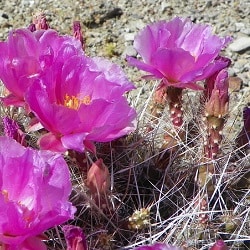
In the book called The New Cactus Lexicon, it was decided that all the species previously classified in Grusonia have been moved to a different group called Corynopuntia, except for one specific species called G. bradtiana. This means that Grusonia is now considered to be a type of genus that only has one species. Grusonia belongs to a subfamily called Opuntioideae, which is known for its glochids (tiny spines), segmented or jointed stems, and leaves that appear briefly on new growth.
Grusonia cacti are mostly short and spread out like mats, with thick spines on low ridges or small bumps. Unlike similar cacti called Cylindropuntia, the spines on Grusonia cacti are not covered with a papery layer, although some may have a bit of this feature. The flowers of Grusonia cacti can be pink, yellow, or even white. They have a cup-like shape and appear waxy or smooth like satin. The fruits of these cacti are typically prickly, juicy, and dry.
Gymnocalycium
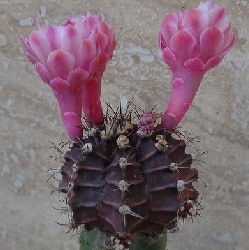
Identifying an unknown cactus and placing it in the Gymnocalycium genus can be easier when you have a flower bud. However, choosing the specific species is a bit trickier. Most species in this genus are round and grow individually. They have ridges on their surface that slightly resemble a chin, earning them the nickname “Chin Cactus.” Typically, each section of the cactus has a few spines of the right size. While there are exceptions, like cacti that grow in clumps or have more tubercles and spines, the presence of flower buds helps confirm that they belong to the Gymnocalycium genus.
The flowers of Gymnocalycium cacti are described as “naked,” meaning they don’t have spines, wool, or bristles. They are smooth and resemble the tip of young asparagus shoots. Most species have white, cream-colored, or pale pink flowers, although a few may be dark red or yellow. The flowers are of moderate size compared to other cacti, usually around 1 to 1.5 inches wide. Gymnocalycium plants tend to produce flowers at a young age but require high heat to fully open. Because of this, they thrive better in a greenhouse, especially if you live outside of Arizona.
Gymnocalycium cacti can reach a height of about 7 inches and a diameter of 12 inches at their largest, although most species stay under 5 inches in height and diameter. These cacti are small in size and relatively easy to care for, which is why they are popular among cactus enthusiasts.
Related Post:
96 Types of Gymnocalycium With Pictures
Haageocereus
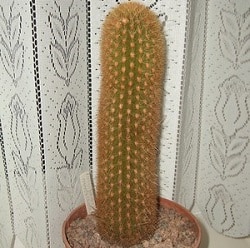
Haageocereus cacti have cylindrical stems with shallow ribs and are covered in closely spaced spines. In many species, the spines make it difficult to see the stems. These cacti can grow upright as tall columns or have sprawling stems that crawl on the ground. The flowers have a funnel-like shape, and the floral tubes can have scales and hairs to different extents depending on the species. These cacti bloom at night but the flowers can remain open during the day. Most of the flowers are white and have a pleasant fragrance, although some may have a pinkish-to-red color. The fruits of Haageocereus cacti are round and juicy.
Harrisia

Harrisia cacti belong to a genus that consists of around twenty species. Some of these species are commonly cultivated and used as plants in warmer climates where they can spread and grow freely. The stems of Harrisia cacti are usually thin and have only a few ribs. They have areoles, which are small areas where spines grow, and these spines are thin and needle-like. This makes the stems easily visible.
All species of Harrisia cacti have large white flowers that bloom at night and give off a pleasant fragrance. The flowers have bristles or wool on their tubes. The fruits of these cacti are round and can be yellow or red. They are fleshy spheres, and the appearance of the fruits can help identify the different species of Harrisia cacti.
Hatiora
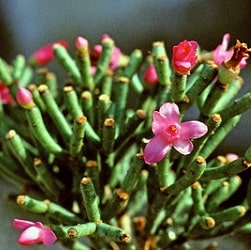
The name of the genus Hatiora was created by botanists Britton and Rose in 1923 to honor a previous botanist named Thomas Hariot. The name was originally spelled “Hariota,” which made more sense, but due to rules in plant naming, this earlier name had to be changed.
Today, the genus Hatiora includes about 5 or 6 species. These cacti are epiphytic, which means they grow on trees in regions that are more wet and humid. The stems of these species can either be flat and leaf-like or round in shape. Some people prefer to use the name Rhipsalidopsis for the species with leaf-like stems. These cacti grow and produce flowers only from the ends of existing stem segments. The flowers can be yellow-orange, pink, or bright red, and the fruits are fleshy and either round or angled.
Hylocereus
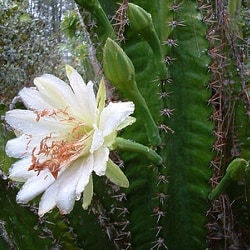
Hylocereus cacti are famous for producing exotic fruits known as Dragon Fruit. The cacti in this genus grow like vines, crawling and climbing their way up trees. Most species do not grow on trees directly but have roots in the ground and then climb upward. These plants can branch out frequently and reach heights over 30 feet, becoming quite massive. The stems typically have three angles with wavy or bumpy edges and may have a few short spines, but not always.
The flowers of Hylocereus are the largest among all cacti, with some exceeding 12 inches in length and diameter. They are primarily white and have a lovely fragrance. They bloom at night, but surprisingly, they remain open for only a few hours on a single night.
Isolatocereus
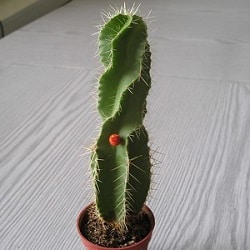
The genus Isolatocereus consists of a single species. These plants closely resemble the Stenocereus species and can be found in the same geographical areas. The plants have shallow ribs, typically between 5 and 8, on stems that can reach up to 6 inches in diameter. Straight and sturdy spines grow closely together along the ribs in specific areas called areoles. The stems have an attractive bluish-green outer skin. The overall growth pattern of I. dumortieri resembles that of a low-branched tree, with long branches extending up to nearly 50 feet. The flowers of this species are greenish-white and bloom at night, but they can remain open during the day.
This plant’s distinct coloring, shape, and spine patterns make it desirable for cultivation, primarily as a landscape plant due to its large size. Although it can be found in cultivation, it is unlikely to see flowers unless the plant is grown in the ground. In their natural habitat, these plants are widespread throughout central to southwestern Mexico.
Lasiocereus
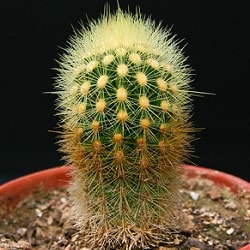
The Lasiocereus cactus has long, cylindrical stems with many vertical lines and small, spiky parts that can be seen easily but don’t cover up the stems too much. Its flowers grow from fuzzy parts of the stem that haven’t fully developed into a special top part. These flowers are shaped like tubes, bloom at night, and have a white color. The tubes have both fuzzy and bristly parts, and they are wider compared to similar plants’ flowers.
Lepismium
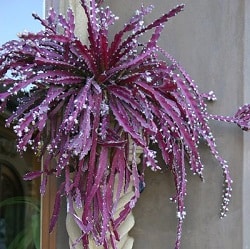
Lepismium species of cacti can be found living on trees (epiphytic) or rocks (lithophytic). They grow in hanging bunches with many branches that start from the middle of the stems. The stems can be flat, angled, or rounded in shape. Flowers grow on the sides of the stems and often cover the entire length of the stem on both sides. These flowers are usually small but bigger than those found in a similar cactus called Rhipsalis. Some Lepismium species have colorful flowers, while others have white flowers that later turn into bright-colored fruits.
Leptocereus
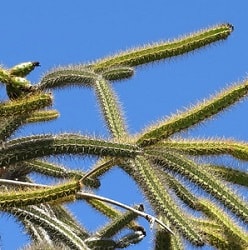
Leptocereus is a type of cactus that includes around a dozen species. These cacti are found in the Caribbean islands, and it’s very rare to see them in cultivation. That’s why most cactus growers are unfamiliar with this genus, only knowing about them through rare photos and limited information online.
These plants are mostly bushy and spread out, but they can also grow into tall trees, reaching heights of up to 30 feet or more. The stems have distinct angles and just a few big ridges. On these ridges, there are spaced-out areas called areoles, which have clusters of about 10 spines. Some of these spines may fall off as the cactus ages. The flowers are either white or whitish-green and often have spines on raised areas of the cactus. In some cases, Leptocereus species can even produce a special top part called a cephalium.
Leuchtenbergia
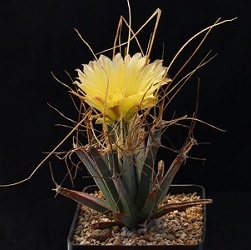
Leuchtenbergia is a unique type of cactus that only has one species called L. principis. What makes it stand out is its special shape, completely different from any other cactus species. You can easily identify it by its incredibly long triangular bumps, known as tubercles, which can grow up to 5 inches long! These tubercles are arranged in a circular pattern, similar to how leaves are arranged on an Agave or Yucca plant. Each tubercle has a spot called an areole at its end, which has long, thin, flexible spines. These spines can be as long as 8 inches!
When the plant grows new tubercles in the center, flowers start to appear. These flowers are bright yellow and can be larger than 2 inches in diameter. They add an extra touch of beauty to this unique cactus.
Lophophora
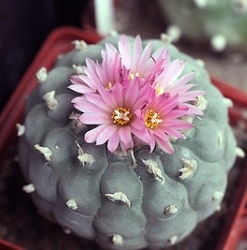
Lophophora is a kind of cactus that doesn’t have any spines. It has a round shape like a button and is found in Texas, specifically from Presidio County to Starr County, along the Rio Grande River. It also grows in parts of Mexico, extending from the northeast to the north-central areas, reaching as far as Querétaro in central Mexico.
Maihuenia
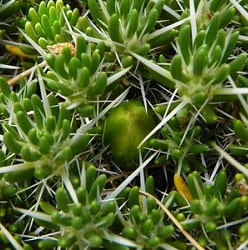
Maihuenia is a special type of cactus that stands out from other cacti because it has its unique group called the subfamily Maihuenioideae. Most cacti have spiky stems, but Maihuenia plants are different. They grow flat on the ground like small mats, made up of short and round segments. These segments have about 3 spines each and even have small, round leaves that don’t fall off like leaves on other cacti.
When it’s time to bloom, the flowers appear at the ends of the stems and can be shades of yellow, ranging from almost white to a bright orange. After the flowers, Maihuenia grows club-shaped fruits that are soft and juicy, inside of which you can find protective layers called bracts. This is what makes Maihuenia an extraordinary and unique type of cactus.
Maihueniopsis

Maihueniopsis plants are interesting because they grow in tight cushions on the ground, with their stem segments packed closely together. The stems have a round or globular shape, and some species even have big taproots that grow mostly underground. Unlike Maihuenia, the leaves on Maihueniopsis plants fall off as new parts of the plant grow. These plants have spines that can be long and abundant, providing protection, or they can be small and tightly pressed against the stem.
When it’s time to bloom, Maihueniopsis plants mostly produce yellow flowers, although sometimes they can be white or even red. These colorful flowers bring brightness to the plant and make it even more fascinating.
Mammillaria
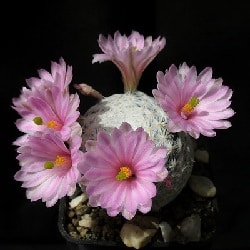
The Mammillaria genus is a big group of cacti with around 200 different species. Most of these species have a round, ball-like shape and can grow alone or in groups. Sometimes, these groups can have many stems and reach over 3 feet tall, but generally, the plants are around 6-8 inches tall and 4-6 inches wide. What makes Mammillaria plants unique are their nipple-like bumps called tubercles, which have different types of spines. These spines can be short and thick, few or many in number, bristle-like, hair-like, or even shaped like a comb. They come in various colors too. Sometimes, in the spaces between the tubercles, there may be fluffy wool or bristles, or sometimes neither.
When it’s time for the plants to bloom, the flowers grow from the spaces between the tubercles in their second year of growth. They often form a ring-like shape around the stem of the cactus. In many species, the flowers are small and pink, less than half an inch in diameter. There are also small yellow or white flowers, but a few species have stunning flowers that stand on long tubes above the plant.
Related Post:
39 Mammillaria Cactus Types and Care (With Pictures)
Mammilloydia
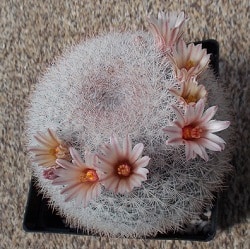
Mammilloydia candida, also known as ‘Snowball,’ is a special cactus that many people find attractive. It has dense spines all over it, which are snowy white in color. The spines are so thick that they almost hide the body of the plant. Mammilloydia is closely related to a similar cactus genus called Mammillaria, but they have unique seeds and other differences that make them separate genera.
Matucana
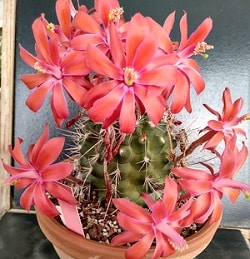
Matucana species of cacti are mostly round or cylindrical plants with shallow lines and light to medium spines. The biggest ones can reach about 30 inches tall, but most are under a foot in height. These cacti have clear bumps on their lines and usually have bright green bodies. The flowers of Matucana cacti are unique and showy. They are often asymmetrical and stand tall above the plant on long tubes. Most flowers are red, but you can also find them in other colors like orange, pink, yellow, or white. The fruits are juicy and round, adding to the appeal of these cacti.
Melocactus
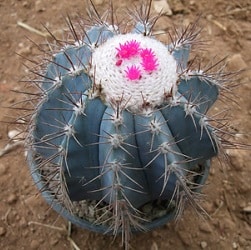
Melocactus is a fascinating type of cactus that looks different as it grows. When it’s young, it looks like a typical green cactus with round stems and spines that look like an asterisk. But as it matures, it develops a strange, bristly “cap” called a cephalium on top of its stem. This cephalium keeps growing, sometimes reaching more than 3 feet in height. Most of the time, the cephalium is white underneath and orange on top, although it can be completely white.
Inside the cephalium, small pink flowers start to bloom. These flowers are not very noticeable, and often, people only realize the plant has flowers when they see the fruit that appears later. The fruits are short tubes, red or pink, that look like wax candles on a birthday cake. The dried remains of the flowers even resemble the wicks of these “candles.”
Related Post:
35 Types of Melocactus With Pictures
Micranthocereus
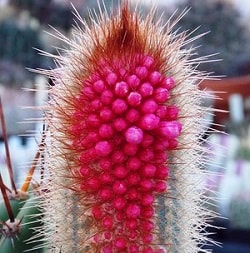
Micranthocereus is a type of cactus that has long, slender stems. These stems can grow as sprawling shrubs or single stems. They have ribs that give them a ridged appearance, and they also have flexible spines and sometimes wool. The flowers of Micranthocereus are small tubes that come in different colors like red, orange, white, or even a mix of colors. These flowers grow from a special area called a lateral cephalium, which is a woolly or spiny growth along the side of the stems.
Miqueliopuntia
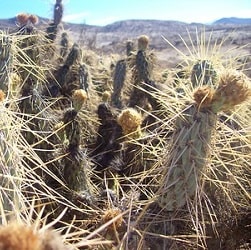
Miqueliopuntia is a genus consisting of a single species from the coast of Chile. The plants can be likened to the North American genus Grusonia in growth habits and appearance. Miqueliopuntia plants consist of cylindrical, jointed stem segments with prominent tubercles. Areoles occur at the top of each tubercle and have many glochids. Spines in the habitat are numerous and shaggy reaching about 3 inches and giving the plants an untidy appearance. Spine density is affected by the environment and “softer” conditions result in smaller and less numerous spine coverage.
Flowers arise from thick, fleshy floral tubes which closely resemble the stem segments. The flowers may be pink or yellowish-green/almost white and are cup-shaped. Fruits are globular and heavily armed with spines and/or glochids. Like many Opuntiads, the fruits themselves can be rooted and grown into separate plants.
Myrtillocactus
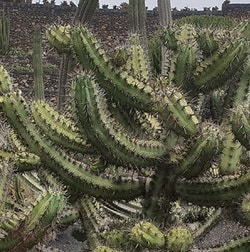
There are four types of Myrtillocactus plants, and they are all similar in some ways. They look like trees and have many branches. These plants have around 4 to 8 noticeable ribs on their stems. Each rib usually has one long spine in the middle and only a few short spines on the sides. Sometimes, the spines might not be there at all. The flowers of Myrtillocactus are small, measuring less than an inch, and they have short tubes that keep them close to the stems.
One interesting thing about Myrtillocactus is that the spiky parts on them called “areoles” can have multiple flowers. These flowers are a greenish-white color and have a waxy appearance. What’s really cool is that groups of flowers can bloom on the stems all at once. After the flowers, blueberry-like fruits start to grow. These fruits are delicious and have been enjoyed by the people of Mexico for hundreds of years. They are still being harvested today and are often sold in local markets. Some people even say that these fruits look similar to Bilberry or true Myrtle fruits.
Related Posts:
4 Types of Myrtillocactus With Pictures
Neobuxbaumia
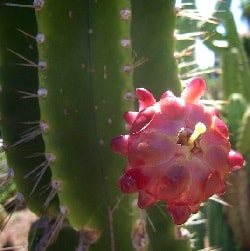
Neobuxbaumia is a type of cactus that can be found in the eastern and southern parts of Mexico. These plants grow in big groups that cover the hills, creating impressive cactus forests. Depending on the author, there are around 8 or 9 different species of Neobuxbaumia. They are all quite large and look like tall trees, reaching heights of nearly 50 feet. The stems of Neobuxbaumia are columnar, meaning they are shaped like columns, and they have many ribs. As these cacti grow older and bigger, they start to branch out. When they’re young, their appearance can vary a lot, depending on the size of the spines compared to the size of the stem.
The younger Neobuxbaumia plants usually have a lot of spines on them. However, as they become adults, the spines on the lower parts of the stems either disappear or become smaller compared to the size of the stem. The ribs on these plants might have small bumps, and the spines on them are not particularly thick, so you can still see the shape of the stems underneath. The flowers of Neobuxbaumia are bell-shaped and can be either white or pink. They bloom at night and are often pollinated by bats. The fruits of Neobuxbaumia are round and have spines on them. When they’re ripe, they split open to reveal a white pulp inside.
Neolloydia
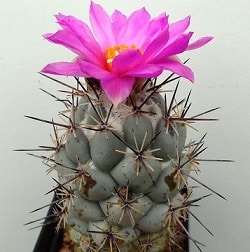
Neolloydia is a special group of cacti. You can find these cacti in two places: the dry scrub areas of southern Texas, specifically Big Bend, and the Chihuahua Desert in Northeast Mexico.
Neoraimondia
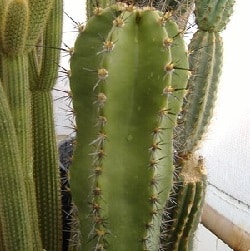
Neolloydia plants are similar to trees and can either have branches close to the ground or grow on a single trunk. The stems of these plants have 4 to 8 ribs with wide spaces in between them.
The flowers of Neolloydia are shaped like funnels and can be white or pinkish in color. Inside the flowers, you can find scales, felted areas, and sometimes even tiny bristles. The fruits of these plants are round and have areoles on them. The seeds are black and have small pits on their surface.
Neowerdermannia

Neowerdermannia is a small group of cacti with only two species. These plants have a round and spiky shape, similar to the Gymnocalycium genus. The flowers of Neowerdermannia grow near the top of the plant and have smooth tubes with scales, which can be either white or pink. The fruits of these plants are round and split open on their own.
The body of Neowerdermannia has ribs, but they’re not very clear and are divided into noticeable bumps called tubercles. Small areas called areoles are found on top of these tubercles, and they produce up to 20 strong spines. These spines can be curved or even hooked.
Obregonia
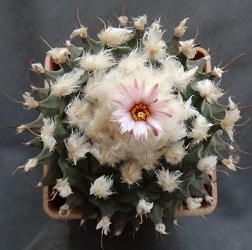
Obregonia, also known as the Artichoke cactus, is a special cactus from Northern Mexico that many people are eager to have. You won’t find it in big plant nurseries, but you can easily find it in specialty cactus nurseries.
This cactus belongs to a genus that only has one species, making it truly unique. It looks different compared to other cactus species, so you can easily recognize it. The stems of the Obregonia cactus are single and flattened, with triangular bumps called tubercles. These tubercles are arranged in a spiral pattern, giving the plant the appearance of an artichoke. At the tips of the tubercles, there are small areas called areoles. They have weak defenses and only a few tiny spines. The flowers of Obregonia are shaped like funnels, and they are white with yellow stamens. They bloom at the center of the top of the plant.
Opuntia
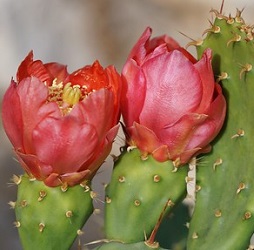
Opuntia is a type of cactus that can be found in many parts of North and South America. It has spread all over the world because people have introduced it to new places where it grows on its own and even becomes a bothersome weed. Opuntia is easy to identify by its flat stem segments called cladodes, which stack on top of each other. These cladodes have tiny spines called glochids on their edges and surfaces. Some Opuntia species have big, sharp spines along with the glochids, while others only have glochids. These glochids may look soft or fuzzy, but they can irritate if touched, so it’s better to avoid them.
Opuntia flowers are usually yellow, sometimes pink, and rarely white. They have a cup shape and don’t have tubes like other flowers. Instead, they look like extensions of the cladodes. When new growth appears, it’s hard to tell if it will be a flower or a new cladode because they look the same at first, often covered in cone-shaped leaves that eventually fall off. Some Opuntias produce fruit, which can turn bright red or stay green. The fruit of certain Opuntia varieties, called “tunas,” are juicy and fleshy. People harvest them to make candies or jellies. In Mexico, young and tender cladodes are also harvested and eaten as a vegetable, known as Nopales.
Related Post:
195 Opuntia Varieties | Types Of Prickly Pear [With Pictures]
Oreocereus
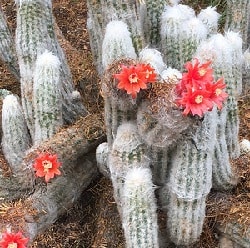
Oreocereus is a type of cactus found in South America, kind of like a counterpart to Cephalocereus in the Northern Hemisphere. They look similar because they’re short and covered in thick white hair or wool. Some Oreocereus species have so much hair that you can’t see the stems underneath. But be careful, because even though they look soft, they have sharp spines sticking out beyond the wool.
People grow several Oreocereus species in gardens because of their dramatic white hairy stems. They are often called “Old Man Cactus” or “Old Woman Cactus.” The stems have ribs and notches between little areas called areoles. Sometimes, these cacti produce flowers, which are usually bright red or orange and beautiful. The flowers have a symmetrical shape and look similar to the genus Cleistocactus. The fruits of Oreocereus are round and fleshy.
Oroya

Oroya is a group of plants that can be found in the Andes mountains in Peru. They are small and have a barrel shape with many ribs. On top of each rib, they have spines that are usually bright yellow or reddish-brown, which makes them look surprisingly striking. These plants have only one stem and they don’t grow very big, reaching up to 13 inches tall and 9 inches in diameter.
The flowers of Oroya plants grow near the top, often forming a circle, and they point straight up. The flowers can be bright yellow or brilliant pinkish-red. They are relatively small, less than an inch long, and have a symmetrical shape with outer parts that curve backward. The fruits of these plants are small, round, and fleshy.
Ortegocactus
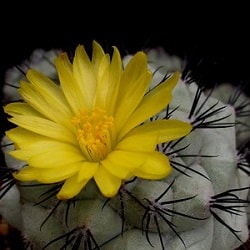
Ortegocactus is a type of cactus that was discovered fairly recently in the 1900s. It only grows in a small area of limestone in Oaxaca, Mexico. When these cacti start, they have single stems that are not more than 2 inches wide. As they get older, they can form small clusters of multiple stems. The stems have rounded bumps on them called tubercles, which have tiny areas called areoles on top. The tubercles are gray-white with black tips. These plants might look more like a blob than a neat round ball, especially when they lack water and get dehydrated.
The flowers of Ortegocactus are bright yellow and shaped like funnels on top of the stems. They have a green stigma. One interesting feature of this plant is its beautiful gray-green skin, which looks porous and resembles actual skin. However, as these plants get older, they can develop rust-colored spots on them, even if they are well taken care of by experienced growers.
Pachycereus
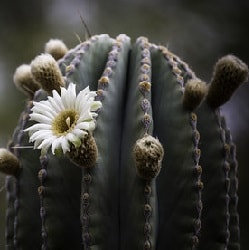
Pachycereus is a group of cacti known for their large size. One species can grow as tall as 82 feet! Although not all Pachycereus species are that huge, they all have a columnar shape and look like trees or shrubs with big branches.
The stems of these cacti have ribs and can be either blue-green or bright green. When they are smaller, they usually have lots of spines for protection, but as they grow older, the spines become reduced or even disappear. Some types of Pachycereus have a special area called a pseudocephalium, which has very dense spines and is where the flowers come from.
The flowers of Pachycereus are small tubes or funnels that can be up to 4 inches long. The tubes have scales and can look bare, fuzzy, or spiny. The fruits of these cacti are fleshy and open up when they’re ready.
Related Posts
14 Types of Pachycereus With Pictures
Parodia
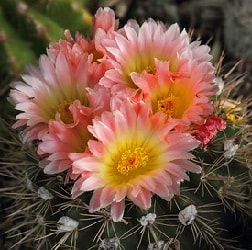
The cacti in the Parodia genus are very popular among plant growers. They are easy to take care of and have interesting stems and spines. These cacti also bloom with bright and colorful flowers, which adds to their appeal. Plants in this group can be round or short cylinders, either standing alone or growing in clusters. Their stems often have ribs, but some can have bumpy tubercles instead. The spines on these cacti can be thin and sparse or dense and stiff.
The flowers of Parodia species grow from fuzzy buds at the top of the cactus. The flowers are cup-shaped and point straight up. Generally, other cacti affiliated with different groups have yellow flowers that are around 1 to 2 inches wide. Parodia species, on the other hand, often have orange to red flowers that can be as small as a quarter inch. However, there are exceptions to these patterns, and some species may differ.
One distinguishing feature of these cacti is their pronounced stigma, which is often a different color from the rest of the flower and has long lobes. This can help identify them. The fruits of Parodia cacti are fuzzy, sometimes spiny, and usually dry. They stay attached to the plant for a long time, even after small black seeds start to fall out. The seeds can vary and can cause disagreements among experts when classifying these cacti.
Related Post:
64 Types of Parodia With Pictures
Pediocactus
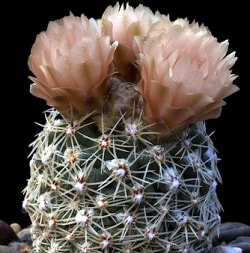
Pediocactus is a group of cacti known as hedgehog cacti. They belong to a larger group called the genus, which includes about 6 to 11 different species, depending on who you ask. However, there are other cacti from different genera like Echinocereus and Echinopsis that are also called hedgehog cacti.
These Pediocactus plants have unique features that make them resemble hedgehogs. They have spines that stick out all over their bodies, similar to the spiky quills of a hedgehog. The number of species in this group can vary depending on different experts and sources.
Pelecyphora
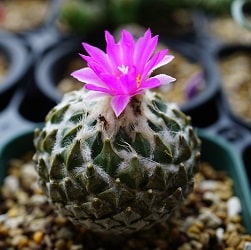
Pelecyphora is a group of cacti with just two species. These cacti come from Mexico. One interesting thing about Pelecyphora is that it has some medicinal properties and may have been used for its psychoactive effects, like another cactus called Lophophora williamsii. It is sometimes referred to as “Peyotillo”.
Peniocereus
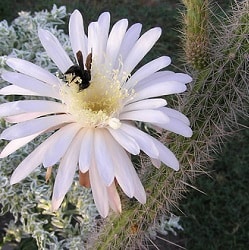
Peniocereus plants, found in the Southwest United States and Mexico, are stick-like plants that sprawl on the ground. They blend in with shrubs, making them hard to notice as they look like dead branches. Some species of Peniocereus have huge underground tubers that can weigh up to 70 pounds or more!
Interestingly, the flowers of these plants are quite stunning and easily catch your eye, unlike their plain stems. Most of the flowers are white, bloom at night, and have long, slim tubes. They also have noticeable bumps with spines or bristles. Sometimes, these flowers even give off a pleasant fragrance. The fruits that grow on these plants are usually large, juicy, and contain black seeds surrounded by white or red fruit pulp.
Pereskia
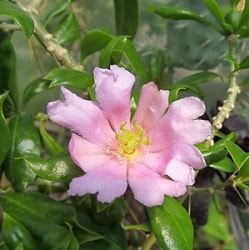
The genus Pereskia is a group of cacti that looks very different from other cacti. While they do have spines and some similar features to cacti, they stand out because they are more like trees or shrubs from tropical regions.
These unique plants have a solid trunk and branches covered in flat leaves. Some people argue that not all cacti are succulents because of Pereskia, but these plants still have some succulent parts, like their roots or stems, and they all have thicker, rubbery leaves. These leaves are juicy, similar to the leaves of a Portulaca plant, rather than thin and papery like those of an Oak or Maple tree.
In their natural habitat, you might have a hard time spotting these plants. They grow among other trees and shrubs, blending in with their surroundings. However, when they bloom, they can be very bright and beautiful. The individual flowers look like wild roses, which is why they are sometimes called Rose Cactus.
Related Post:
8 Types of Pereskia With Pictures
Pierrebraunia
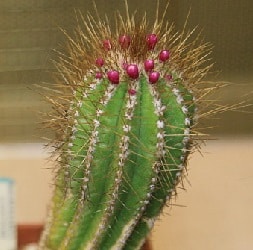
These unique plants have a ribbed appearance and short columns. They grow in Brazil and are only found in small numbers in their natural habitat. These plants produce beautiful bright-pink tube-shaped flowers that grow near the tips of their stems.
Pilosocereus
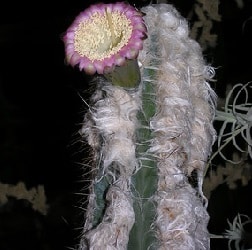
The Pilosocereus genus, previously known as Pilocereus, got its name changed in 1954 because of a discrepancy in the botanical naming rules. The old name referred to the hairy parts, called areoles, found on the stems, particularly in the mature flowering sections. Many species within this genus have stunning blue-colored stems, although some may be green instead.
These plants can either be bushy or grow into tall tree-like structures. Their flowers are tube-shaped, and the floral tubes and unopened buds often have a vibrant blue color. The outer parts of the flower, called perianth, are usually white or pinkish-white and have many stamens and a style that sticks out. The floral tubes are smooth and don’t have any spines. Interestingly, these plants rely on bats for pollination. Their fruits are juicy and contain seeds surrounded by pulp.
Related Post:
44 Types of Pilosocereus With Pictures
Polaskia

The Polaskia genus consists of two tree-like cacti found in Southern Mexico. These plants have a tall trunk that branches out as they grow older, with many branches extending from a short base. The stems have ribs and the spaces between them are not very deep. Along these ribs, you can find areoles spaced around an inch apart. The spines on these cacti are short and sturdy, with about 8 to 10 spines in a circular arrangement around the areole, and sometimes there is a single spine in the middle. However, it’s important to note that mature plants may not have any spines at all.
The flowers of Polaskia cacti are like wide-open cups and can be either pinkish-white or yellow-green in color. Some flowers have spines, while others do not. The fruits of these cacti are small and contain fleshy berries.
Pseudorhipsalis
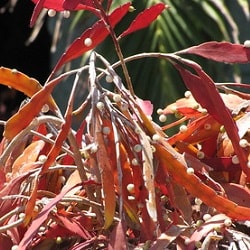
Pseudorhipsalis is a type of plant that is sometimes grouped with Disocactus. It has an interesting growth pattern. Initially, it stands tall and upright, but as it grows, it starts to trail along the ground. This plant is called epiphytic, which means it grows on other plants without harming them. Pseudorhipsalis has many branches and elongated stems. Its leaves are flat and have jagged edges. One notable feature of Pseudorhipsalis is that it produces a lot of flowers.
Pterocactus
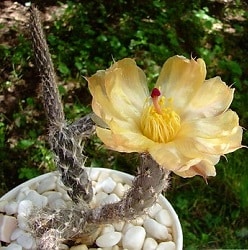
Pterocactus stands out in the cactus family due to its extraordinary flowers. These flowers are embedded so deeply in the stems that the entire stem appears to be one long floral tube. When a flower blooms, it emerges straight from the end of the stem. This unique process stops the growth of the stem, and a new stem grows from the side, eventually producing another flower.
If the flower is successful, the end of the stem transforms into a dry fruit. Eventually, this fruit opens up, revealing seeds that have wide wings. These wings are quite distinct and uncommon within the cactus family. Interestingly, these seeds resemble the seeds of an Elm tree. Additionally, Pterocactus species have large tuberous roots that continue to grow, while the stems may wither away and be replaced by new ones over time.
Pygmaeocereus
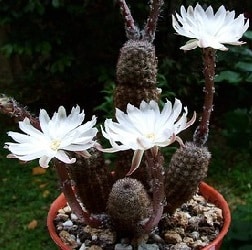
Pygmaeocereus is a unique genus of cacti known for its small, cylindrical stems that grow in clusters. These stems have shallow, bumpy ribs with numerous spines that are not sharp or aggressive. The flowers of Pygmaeocereus bloom at night and are white in color. They appear at the ends of long, slender floral tubes that have scales and are covered in tiny hairs.
In their natural environment, Pygmaeocereus species can only be found in Peru, specifically in the foggy areas along the coast. Although these cacti are not commonly grown for commercial purposes, they are cherished by dedicated cactus collectors who appreciate their unique features.
Quiabentia
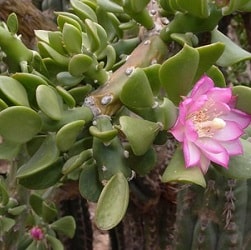
Quiabentia is a unique cactus genus that includes only one species. This cactus grows in a way that resembles a typical deciduous tree. It has a single trunk with branches that form a crown at the top. The branches are covered in broad, flat leaves that have a slightly succulent texture.
Quiabentia shares some similarities with other cacti like Pereskia or Pereskiopsis. However, it is believed to be more similar to Pereskiopsis because it has small, hair-like structures called glochids on its areoles. The flowers of Quiabentia are either red or pink and they bloom at the tips of the stems. These flowers have spines and glochids on their floral tubes. The fruits of this cactus are fleshy and contain large, round seeds.
Rebutia

Rebutia is a popular genus of cacti that many people enjoy growing. Some species from this genus are even produced and sold on a large scale in garden centers worldwide. These plants are small and have a rounded or flattened shape. They often grow in small clumps. The stems of Rebutia cacti usually have bumpy areas called tubercles, but the ridges between them are not always well-defined. One interesting thing about Rebutia cacti is that their spines can vary widely, even among plants of the same species.
These cacti are known for their vigorous growth and they often produce many beautiful flowers. These flowers are relatively large and have eye-catching, bright colors. They emerge from specific spots on the cactus called areoles, usually on the lower parts of the stems. The flowers of Rebutia cacti have a funnel-like shape, with floral tubes that sometimes extend and curve upward over the plant. These floral tubes have scales and may even have tiny hairs, but they don’t have spines like the rest of the cactus.
Rhipsalis
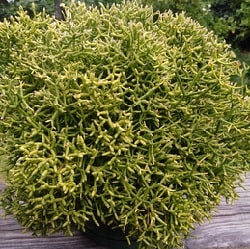
Rhipsalis is a type of cactus that is known as Mistletoe cactus because of its unique growth habit. These cacti are epiphytic, which means they grow on other plants without harming them. Most Rhipsalis species are found in Brazil. The name “Rhipsalis” comes from an Ancient Greek word meaning “wickerwork,” which describes the plants’ appearance and how they grow.
Schlumbergera
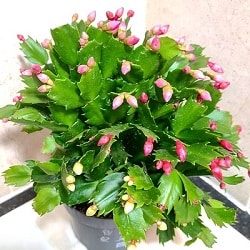
This is a small group of cacti known worldwide as the “Christmas Cactus”. However, not all species in this group are considered as such. The true “Christmas Cactus” is actually a hybrid created in Europe and has been widely spread through cuttings for at least 150 years. Its proper name is Schlumbergera x buckleyi.
These cacti have stems that look like leaves growing from end to end, or in two species, the stems are rounded and covered with small spines. The flowers are beautiful and have curved petals. They can be bright red or pink and sometimes have two colors. The fruits of these cacti are small berries.
Related Post:
13 Types of Schlumbergera With Pictures
Sclerocactus
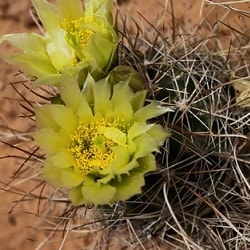
Plants in this group grow naturally in the Southern United States and Northern Mexico. They survive in tough conditions and can be found in small populations. It’s interesting to note that these plants can handle different types of weather. However, despite their ability to thrive in the wild, they are quite challenging to grow at home. Those who do succeed often use a specific type of soil without any organic materials.
These plants are generally small and have a rounded or cylindrical shape with bumpy ribs. They usually have many spines, including a hooked central spine. The flowers grow at the top of the plant and face upwards. They come in different colors like pink, yellow, greenish, white, and even brown. The fruits are similar to those of another cactus called Ferocactus, but they have small tufts of wool in the scales.
Selenicereus

This group of plants is called Selenicereus, named after the Greek moon goddess Selene because their flowers bloom at night. These plants are similar in that they are vine-like climbers. They mostly grow on trees but can also be found on rocks. The stems of these plants can be round, angled, or even flat and jagged like fern leaves. Some species have no spines, while others have tiny hair-like spines, and a few have stronger protection. They also have roots along the stem that help them climb.
These plants have beautiful flowers that open at night and are quite amazing. Some can be larger than 12 inches in diameter. Most of them have long, slender tubes with scales, hairs, bristles, or spines. The fruits they produce are fleshy and have spines that don’t fall off easily. The flowers are mostly white, but some have red or yellowish parts on the outside.
Related Post:
31 Types of Selenicereus With Pictures
Stenocactus
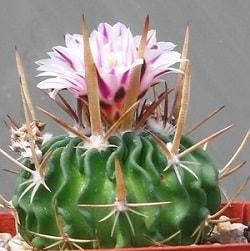
There are several species of cacti in the Stenocactus group that people enjoy growing. These plants are round and stay relatively small, making them easy to take care of in pots. They are known for their ability to grow and bloom quickly, often being one of the first cacti to flower in the spring. What makes them even more interesting is that their ribs resemble fins, giving them a coral-like appearance as if they belong under the sea.
These cacti usually have spines that are noticeable but not overwhelming, allowing you to see the stem. The flowers grow at the top of the plant and are often white with a dark pink stripe in the middle, although sometimes they can be plain creamy white. These cacti are native to the Chihuahuan desert in Mexico, where they naturally thrive.
Stenocereus
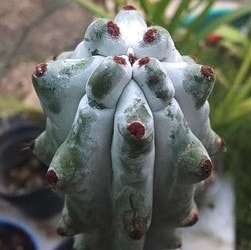
Stenocereus is a group of cacti that are mostly large, shrubby, or tree-like with tall, columnar shapes. They can be found in many places, including the Southern United States, Mexico, Central America, the Caribbean, and Northern South America.
These cacti have cylindrical stems with many noticeable ribs. The ribs have small grooves where the spines grow. The flowers of Stenocereus are short and have a wide, funnel-like shape. The outer petals curve backward, and you can see the long stamens inside. The tubes of the flowers are covered in spines, but these spines fall off as the fruit begins to develop.
Related Post:
29 Types of Stenocereus With Pictures
Stetsonia
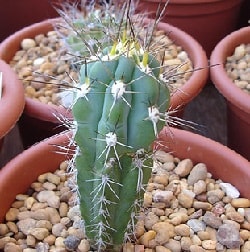
The Stetsonia genus only has one species, and it’s a big cactus that grows like a tree, with a strong trunk and lots of branches. It is one of the most popular large cacti that people grow. It is commonly seen in stores when it’s still small and kept in pots instead of being planted in landscapes. Because of this, it’s rare for these cultivated plants to have the chance to bloom. However, one unique feature of this cactus is its very long spines, which is why it is often called the “Toothpick Cactus”.
The stems of Stetsonia have many shallow ridges and sharp spines. As the cactus grows older and bigger, it may start branching out. The flowers of this cactus are white and have a funnel-like shape. They open at night and stay open during the day. This genus of cactus is found in many places in southern South America.
Strombocactus
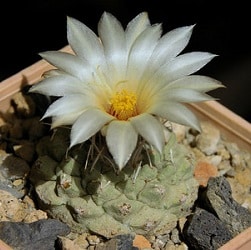
Strombocactus disciformis is a special kind of cactus that is quite rare. It has a solid, roundish stem that looks like a turnip and is covered with small, spirally arranged bumps. These bumps have spines on top. The stem itself is only about 3.2 inches tall and is a bluish-green color with a hint of gray.
Tephrocactus
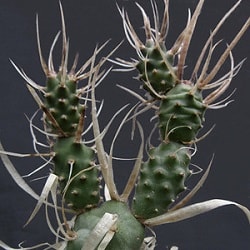
Tephrocactus is a small group of cacti found only in Argentina. One interesting thing about these cacti is that they have glochids, which are tiny spines that stick to your skin. However, in Tephrocactus, these spines are unique because they are sunken into the areoles, which are special spots on the cactus where the spines grow. The spines can be long and thin like needles, or they can be thin and papery, or sometimes they may not be there at all.
The stems of Tephrocactus are made up of separate segments that grow in a distinct pattern. Unlike other cacti like the Opuntia with their flat pads, the segments of Tephrocactus are round in shape. They can be short cylinders, egg-shaped, or even completely spherical. These segments are arranged in a slightly zig-zagged stack. The flowers of Tephrocactus are mostly white, but some can be pinkish, yellow, or even red in one species.
Thelocactus
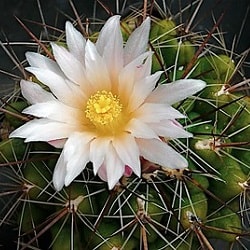
Thelocactus is a group of around twelve species that can mostly be found in the Chihuahuan desert in Texas and Mexico. These plants have small, rounded, or short cylindrical stems. Sometimes they grow alone, and other times they form small clusters. The stems have ribs that are bumpy and often have strong, needle-like spines. In certain species, these spines are even curved like hooks.
The flowers of Thelocactus can be white, pink, or yellow, and sometimes they have a combination of colors in rings or stripes. Compared to the size of the stems, the flowers are usually quite big. They bloom at the top of the plant and can even continue blooming throughout the summer.
Tunilla
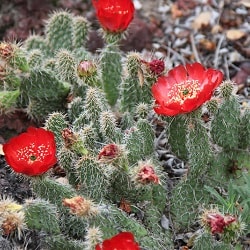
Tunilla is a small group of cacti from South America. These cacti were not commonly grown in the past, but now more people are becoming interested in them. The stems of Tunilla can either be flat with joined paddles or round segments. They have special spots called areoles that contain tiny spines and glochids, which are like little stickers. The flowers of Tunilla are colorful, ranging from red to yellow and all the vibrant shades in between.
The fruits of Tunilla have a single slit and open up to release their seeds. You can find these cacti in countries like Argentina, Bolivia, Chile, and Peru.
Turbinicarpus
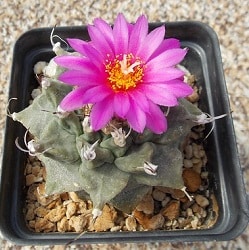
This group of plants is called Turbinicarpus, which comes from a combination of Latin and Greek words referring to their top-shaped stems. These cacti have small stems that are usually partially buried in the soil where they grow naturally. When grown as houseplants, they often have round stems with noticeable bumps. The spines on these plants can look quite different depending on the species. The flowers grow at the top of the stems and can be white or dark pink in color.
Uebelmannia
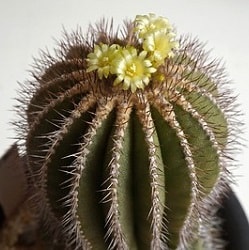
There are three types of plants from Brazil called Uebelmannia. These plants have stems that are round or cylindrical and have ribs with spines on them. The skin of the plants feels rough and can be bright green, waxy-gray, or dark purple. The spines on the plants are usually white, golden, or black and are found in a continuous line on the ribs. These special features make these plants look very unique and beautiful. The flowers of these plants are small yellow funnels that grow near the top of the stem. Although the flowers are not very special compared to other cacti, the plants themselves are quite striking because of their appearance.
Weberocereus
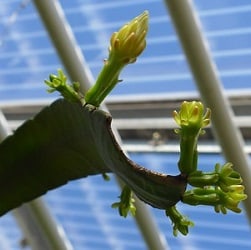
Not many people grow plants from the Weberocereus family because they are rare and not commonly found in gardens. These plants are usually found in Central America, and some species can be found in Mexico and Ecuador.
The plants from this family have long, vine-like stems and they grow aerial roots as they climb. The stems can be round, angled, or flattened in shape. There are only a few spines or sometimes no spines at all on these plants. The flowers of these plants bloom at night and they are shaped like funnels. They are mostly white, but some can be pinkish or yellowish.
Yavia
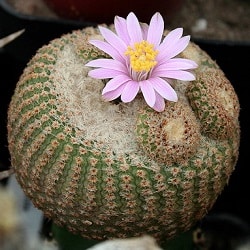
Yavia is a type of cactus that was discovered in 2001. It lives in a tough and dry environment with rocky soil, high up at over 12,000 feet elevation. This cactus is small and round, usually with only one stem, although it can sometimes grow in clusters if it’s grafted. You can see some faint ridges on its surface, but what stands out are the rows of fuzzy-white spots called areoles, which have tiny reddish-brown spines. The flowers of this cactus are pink and have a short, thick tube.
What Type of Plant is a Cactus?
Cactus belongs to the succulents group, plants that can absorb and store large amounts of water in their plant body and roots. In this way, they can go without water for extremely long periods. The thorns also have a similar function. They can absorb dew and thus provide extra moisture.
The cactus is from the plant family of the Cactaceae. There are about 300 genera and 3,000 species. The family has many well-known species because they are easy to keep alive as a houseplant and are seen as decorative.
The plants can be classified according to their shapes. There are the disc shape, the spherical shape, and the columnar shape. Certain cactus types can become very large, while others remain very small.
There are many other types of succulents in the world, but they lack areoles, places where the thorns (spines) grow. This is characteristic of cacti and family characteristics.
Most cacti are native to North, Central, and South America. They occur there in deserts and steppes, on high mountain slopes, and in jungles. They are masters of adapting to living conditions. A small number of species occur in tropical rainforests. They then grow as epiphytes on tree branches where, despite the high rainfall, due to the rapid flow of water, dry conditions predominate.
When you’re repotting a cactus, it’s really easy to end up pricking yourself multiple times, which can risk you dropping and damaging your plant. A pro tip is to use a pair of high quality pliers or very thick gloves to keep you away from those spines and give you the control you need to take care of your cactus.
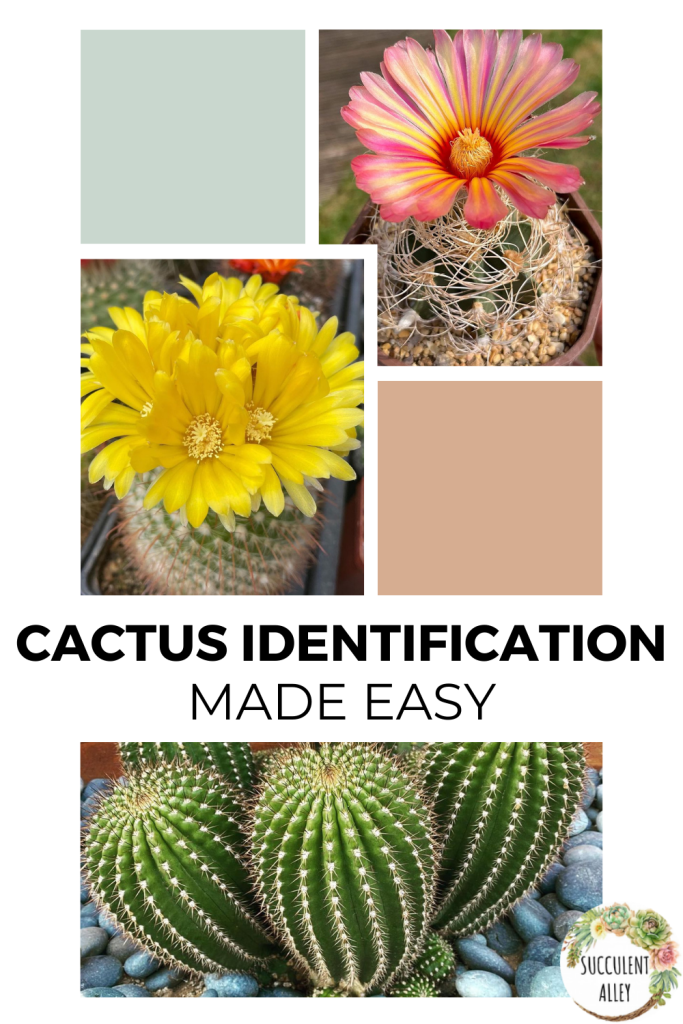
Sources:
https://en.wikipedia.org/
https://cactiguide.com/
https://www.llifle.com/

